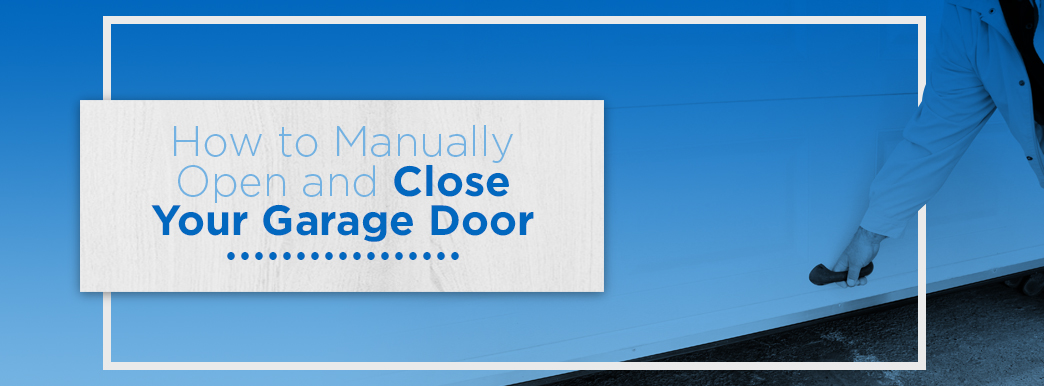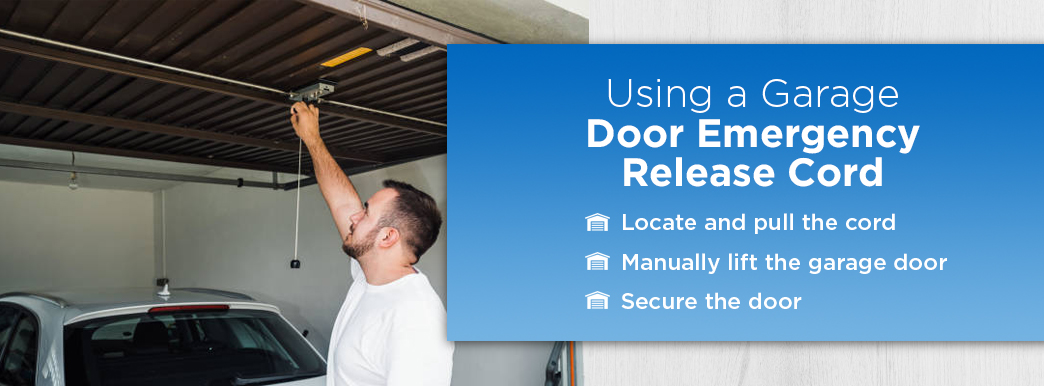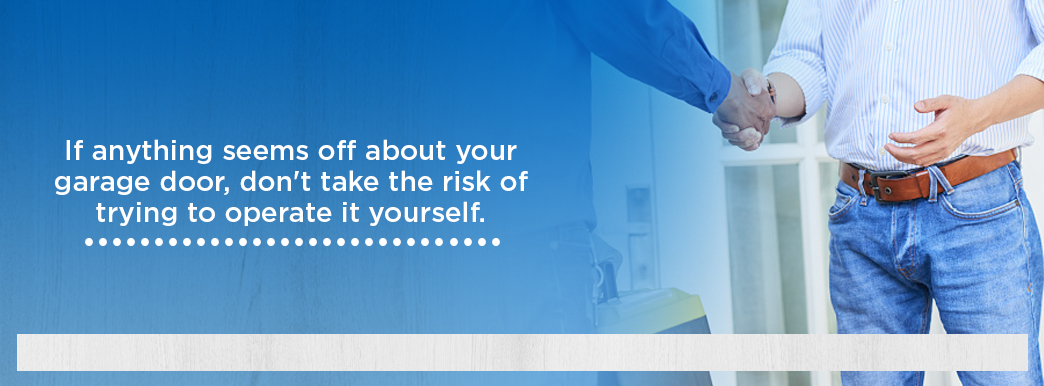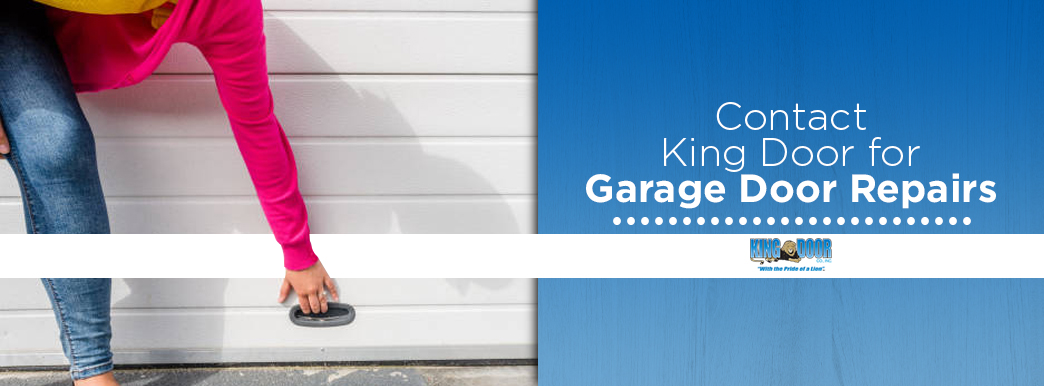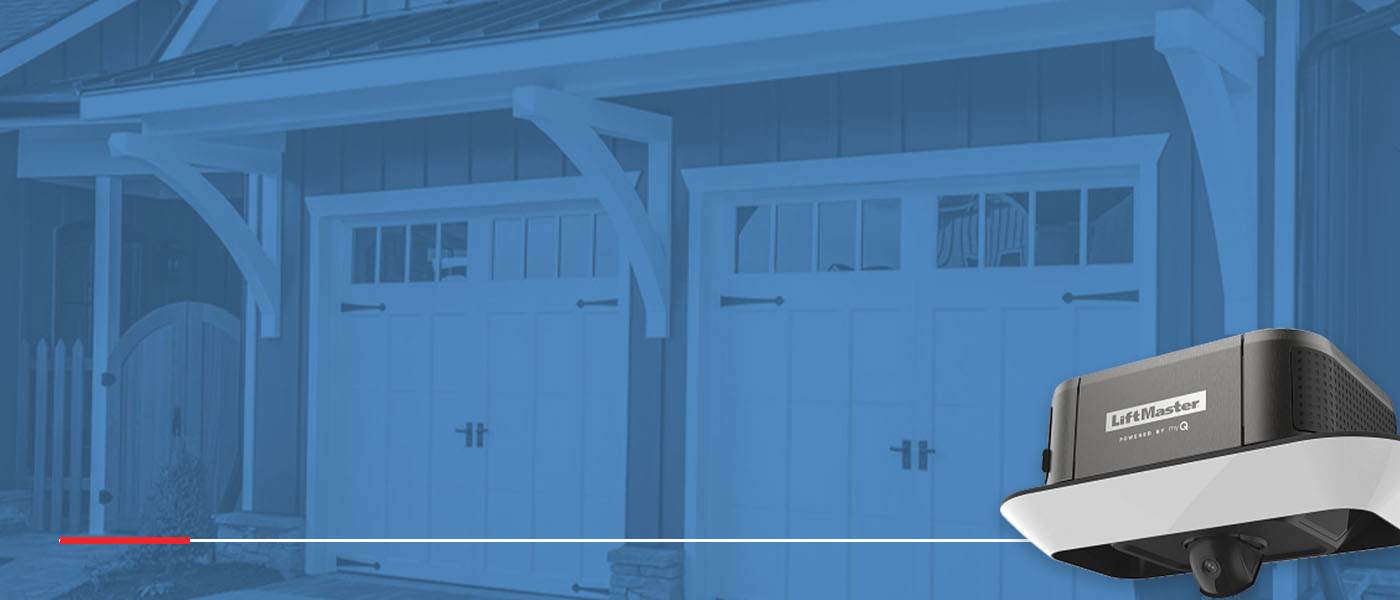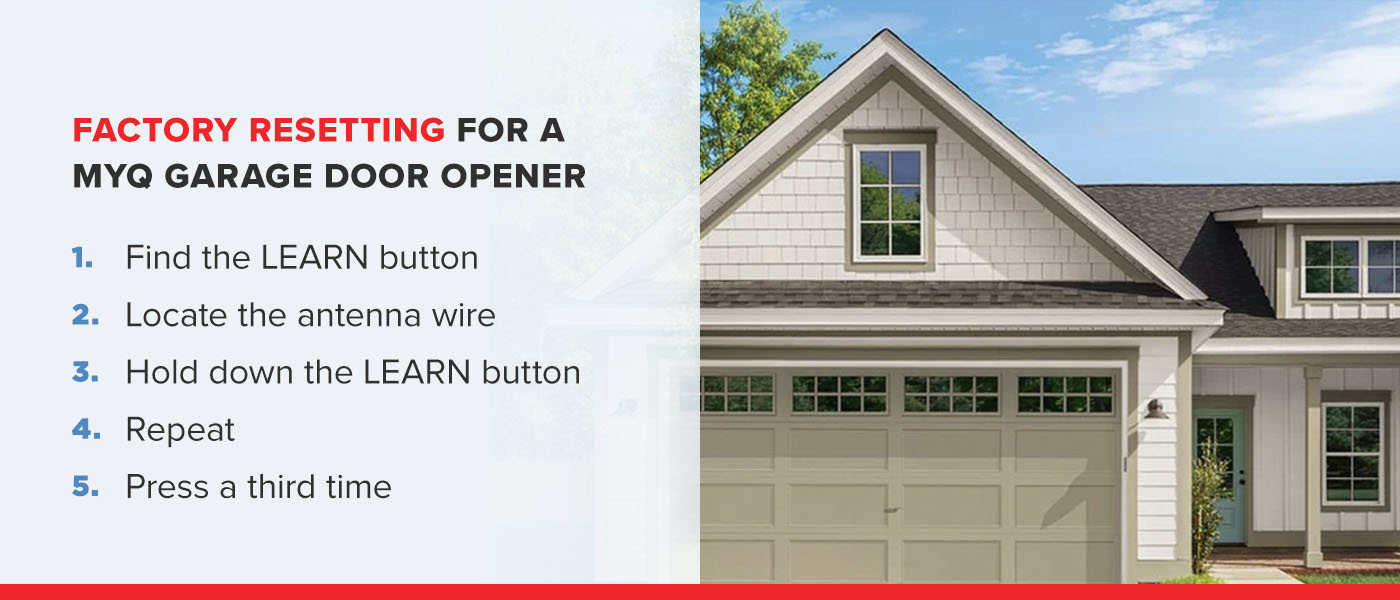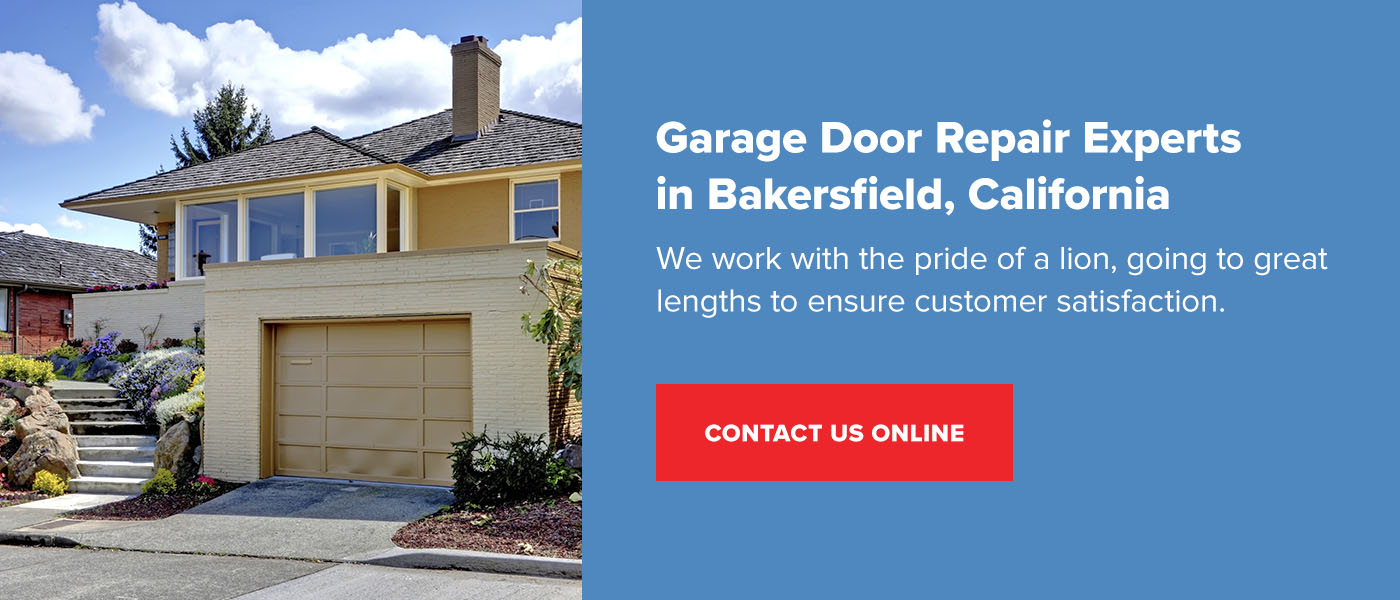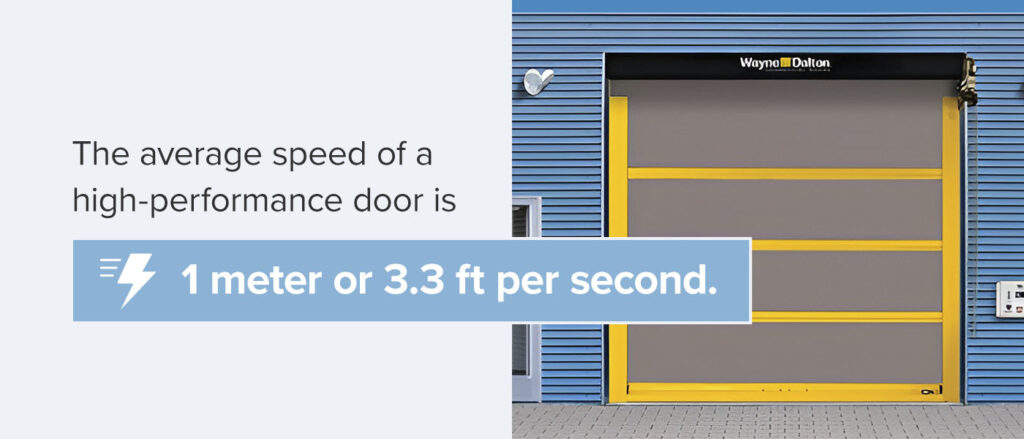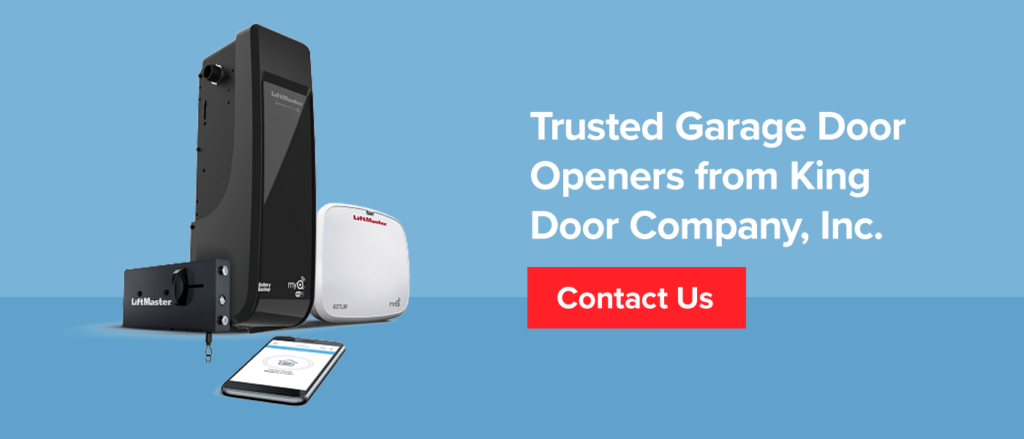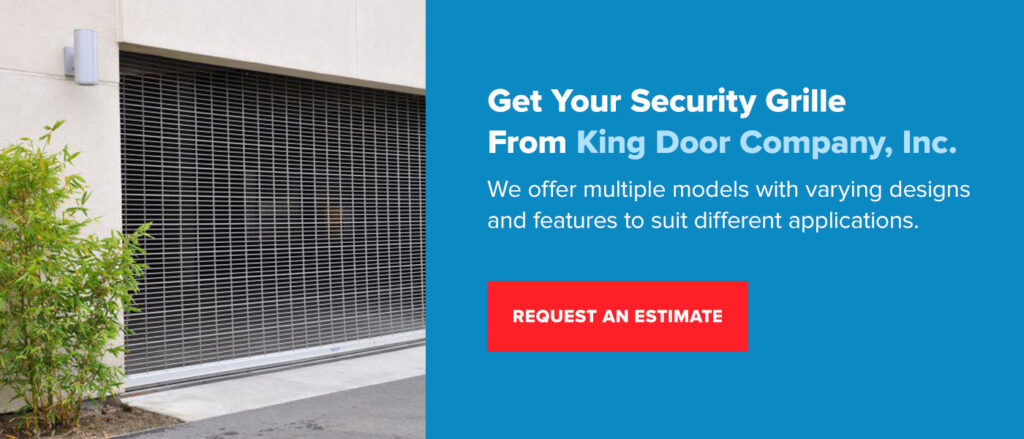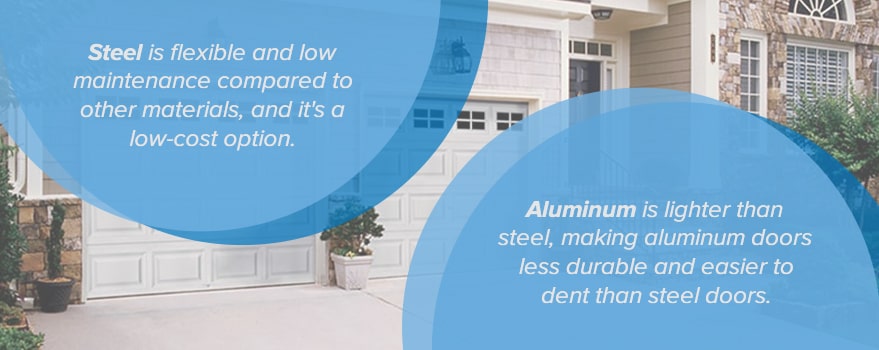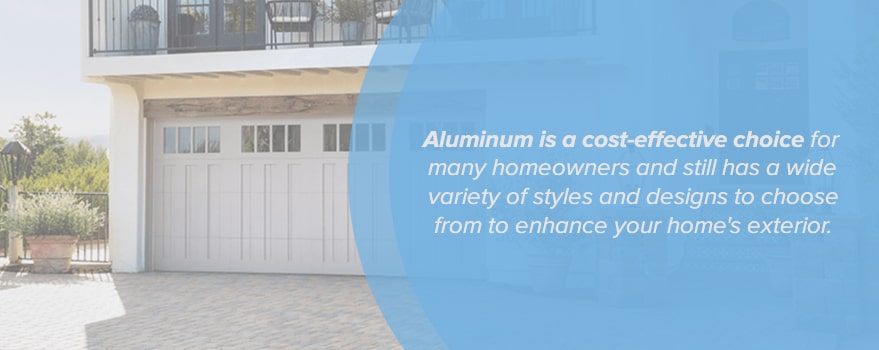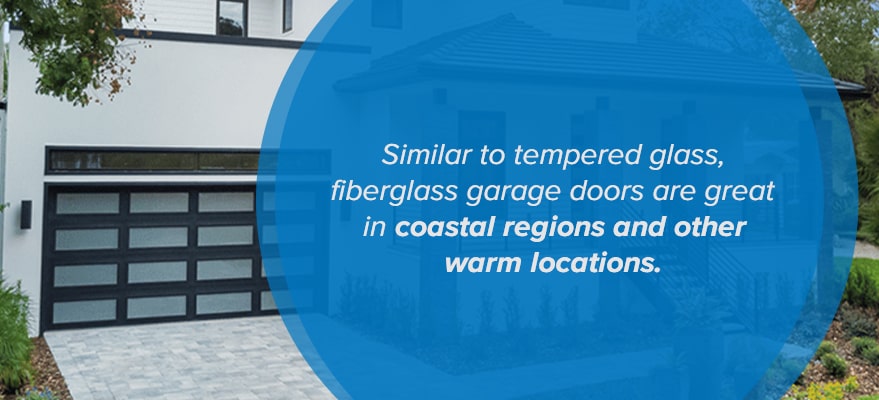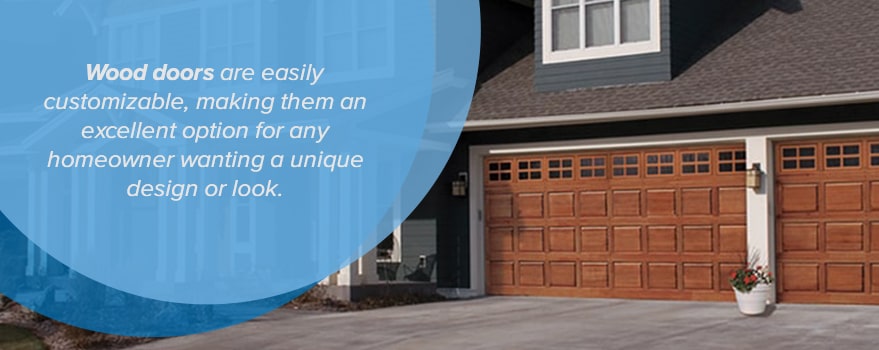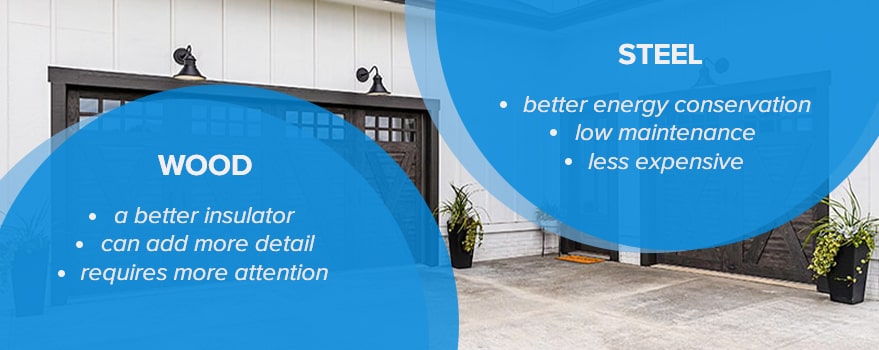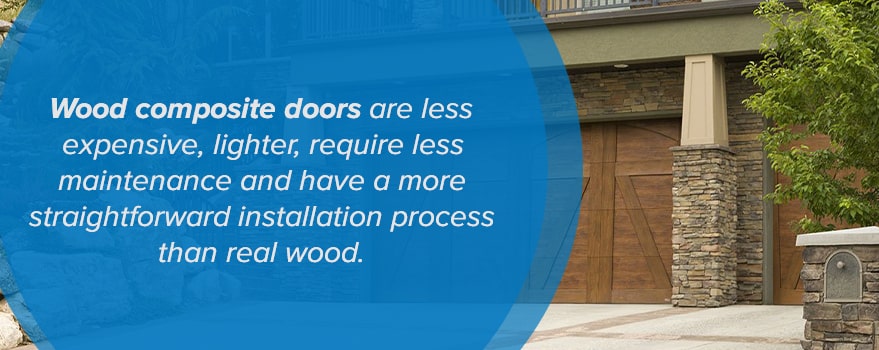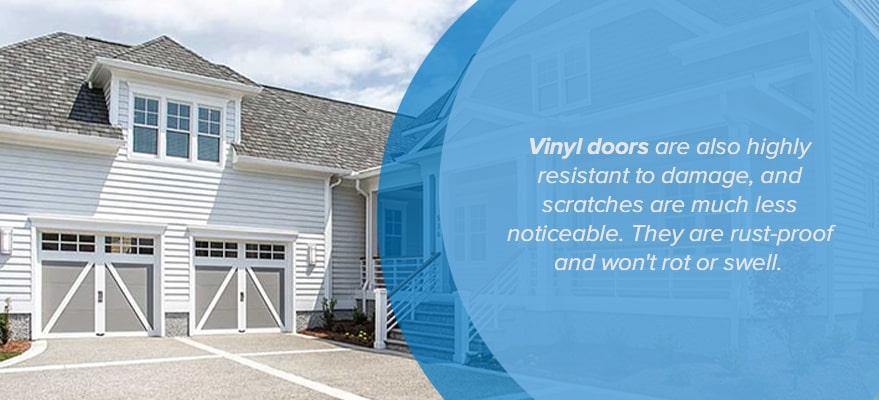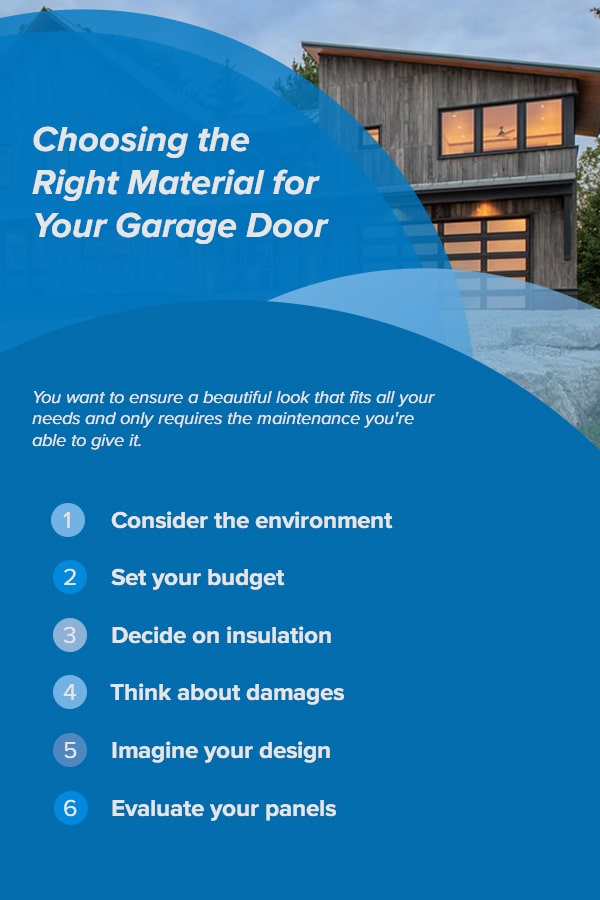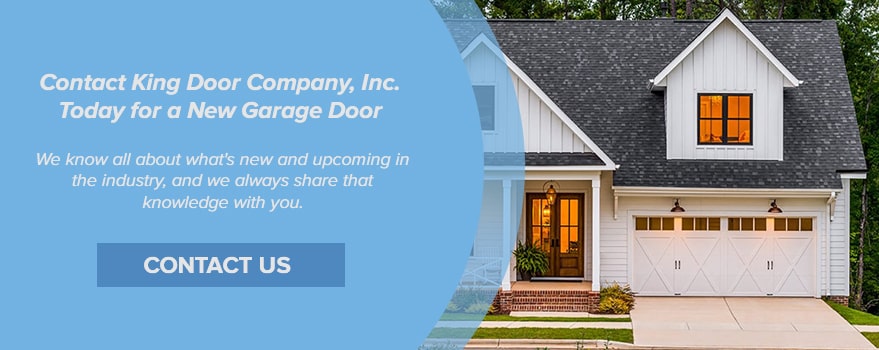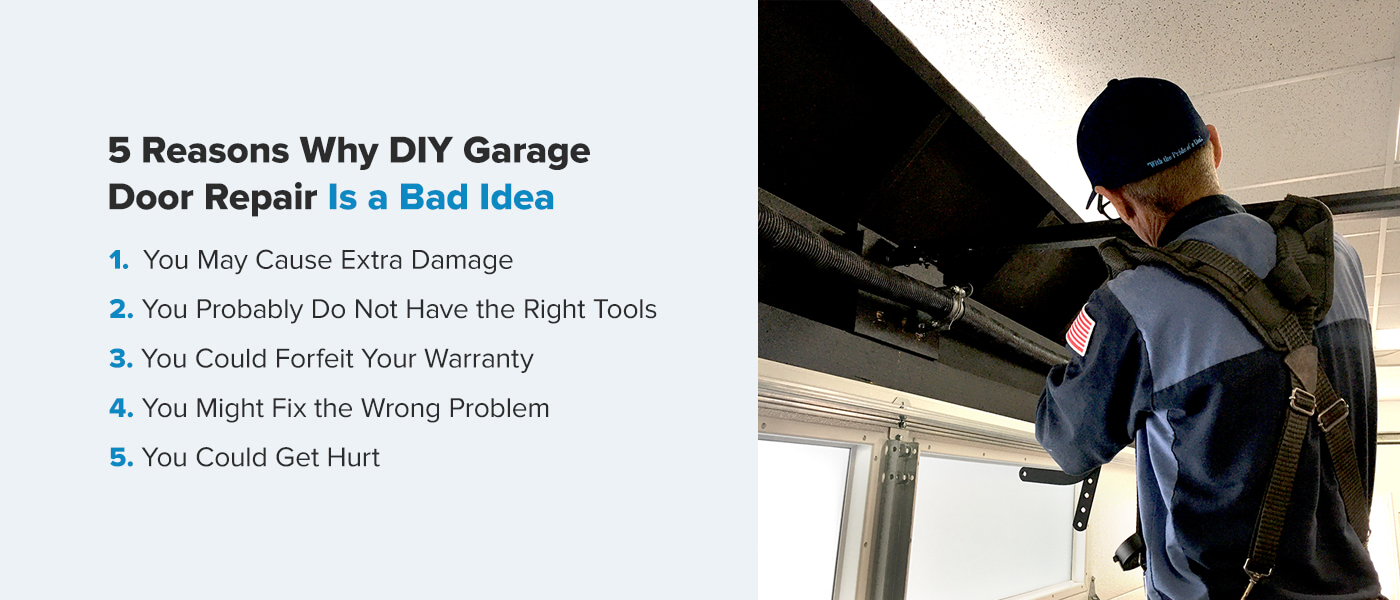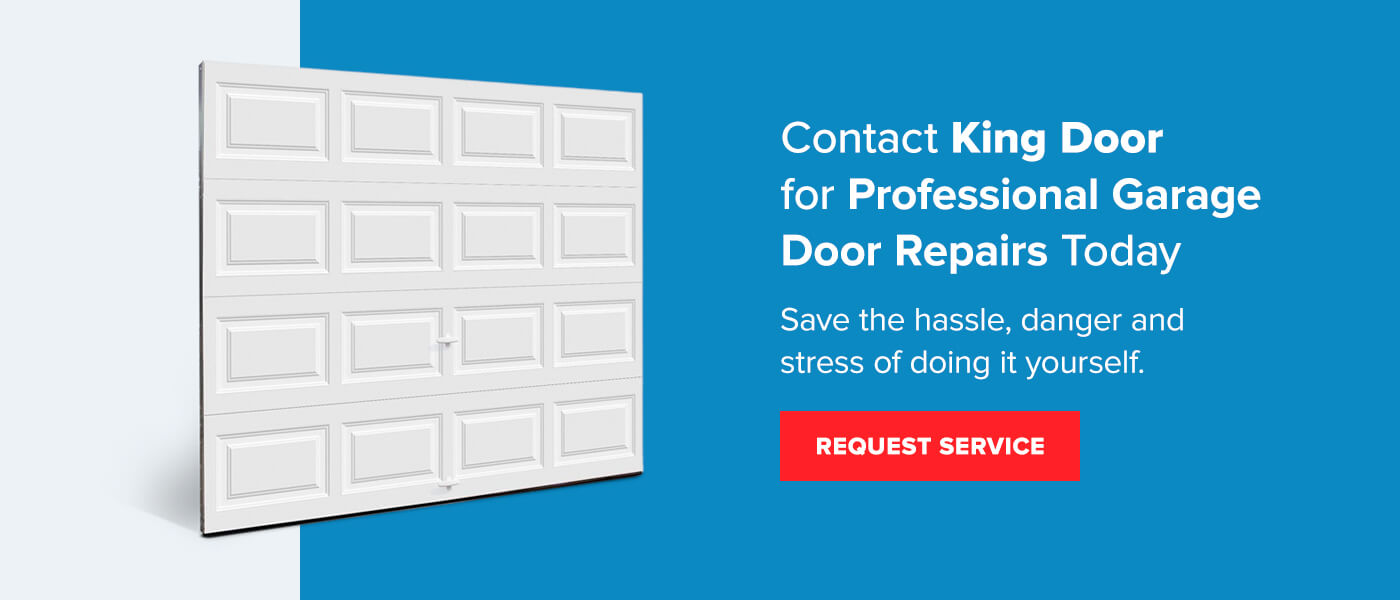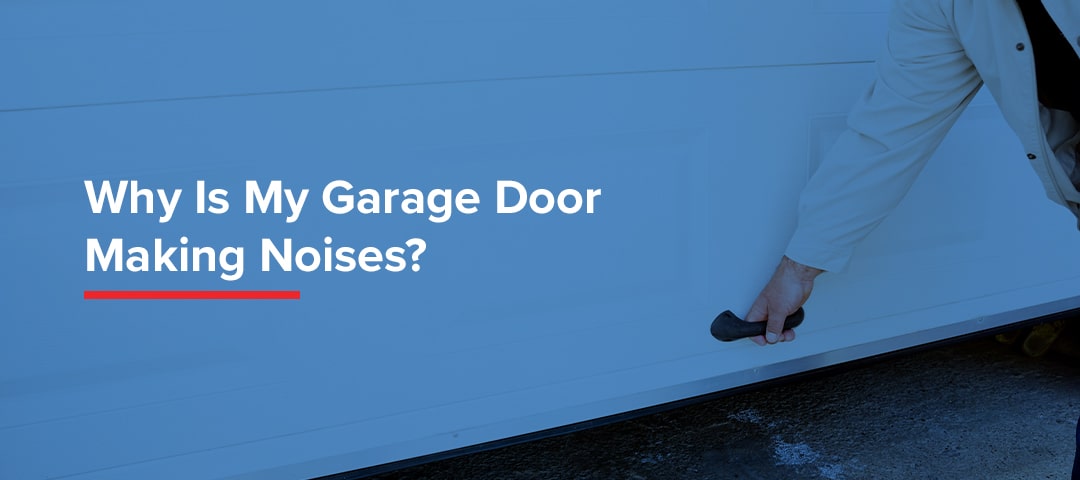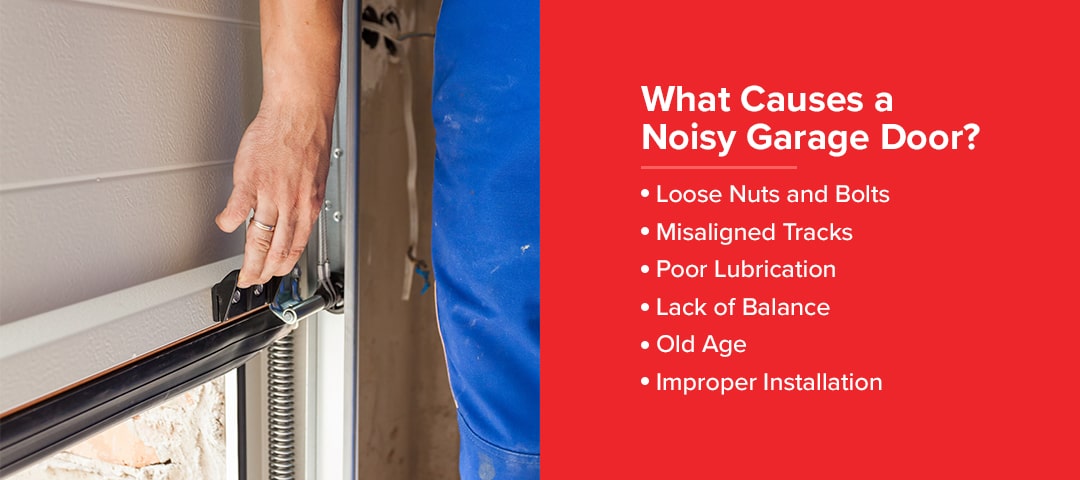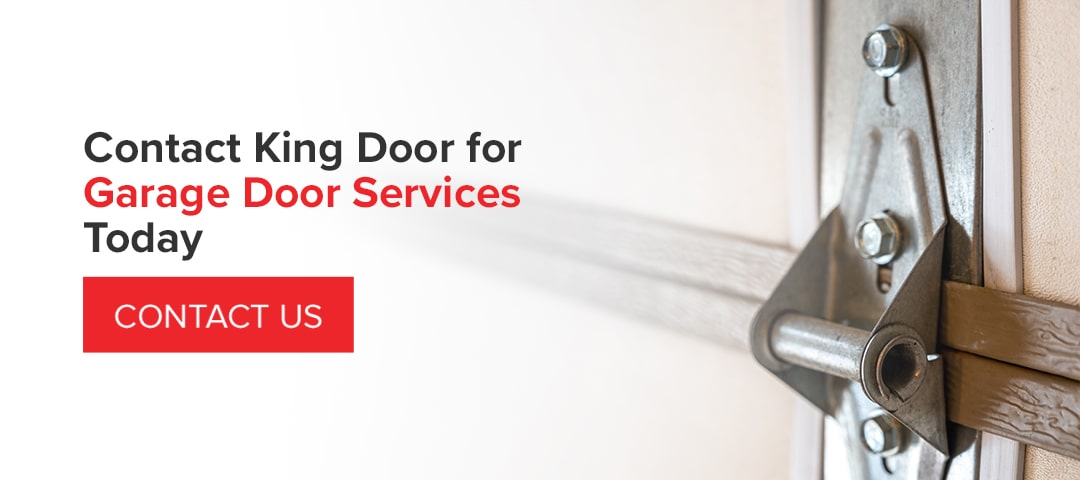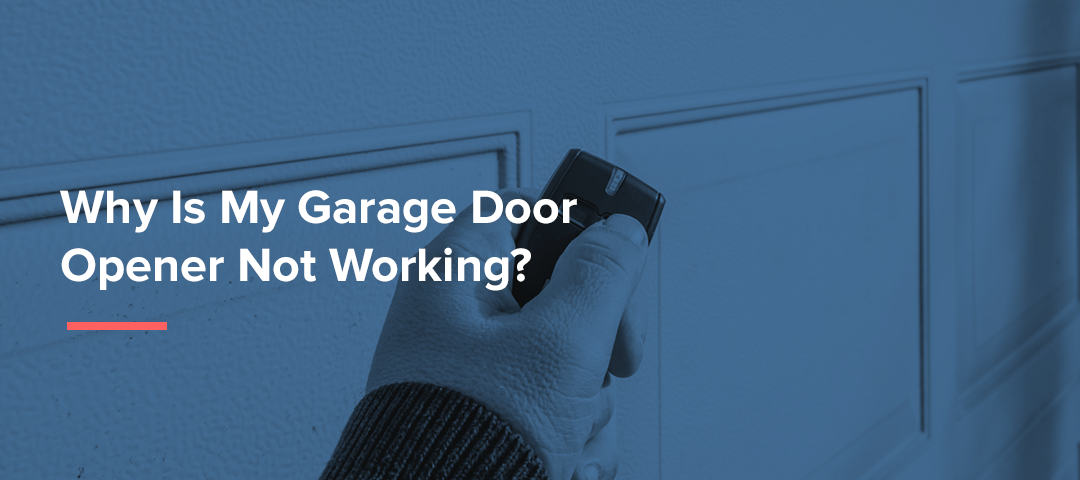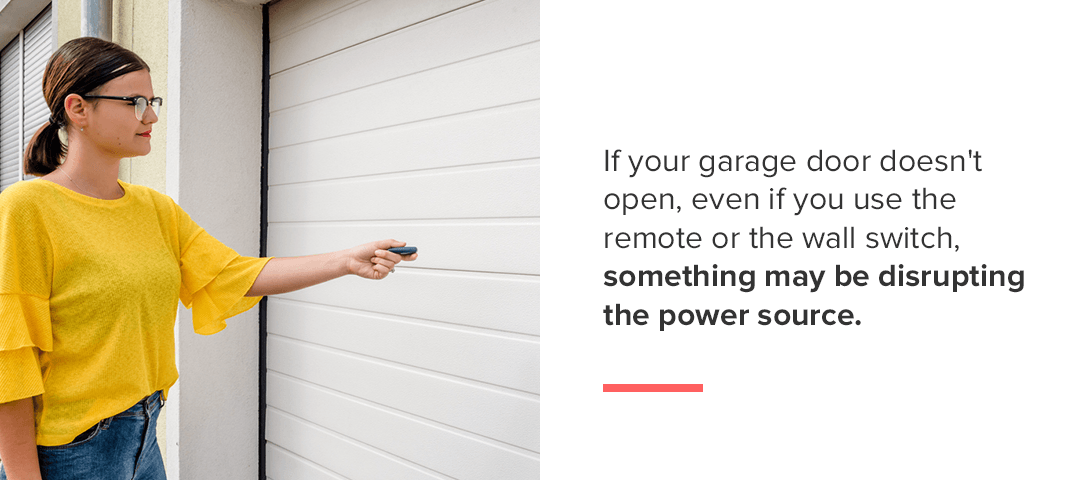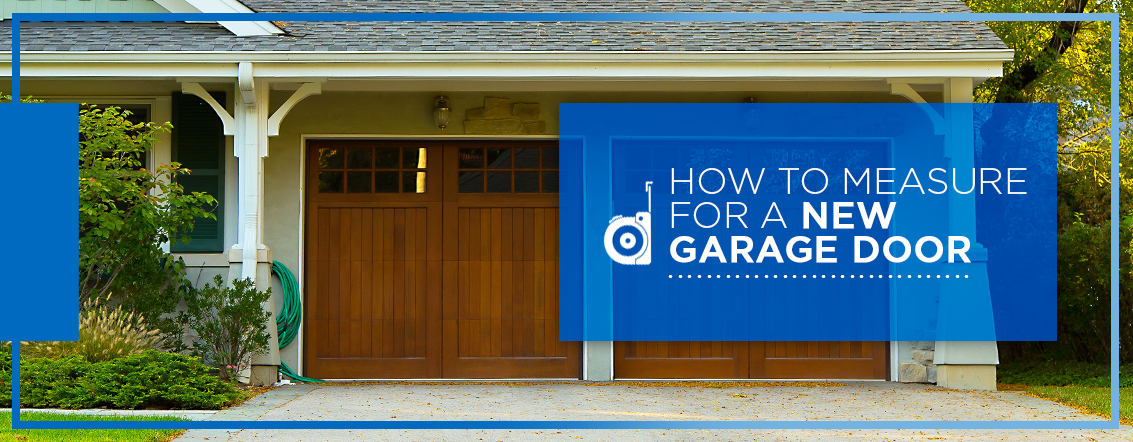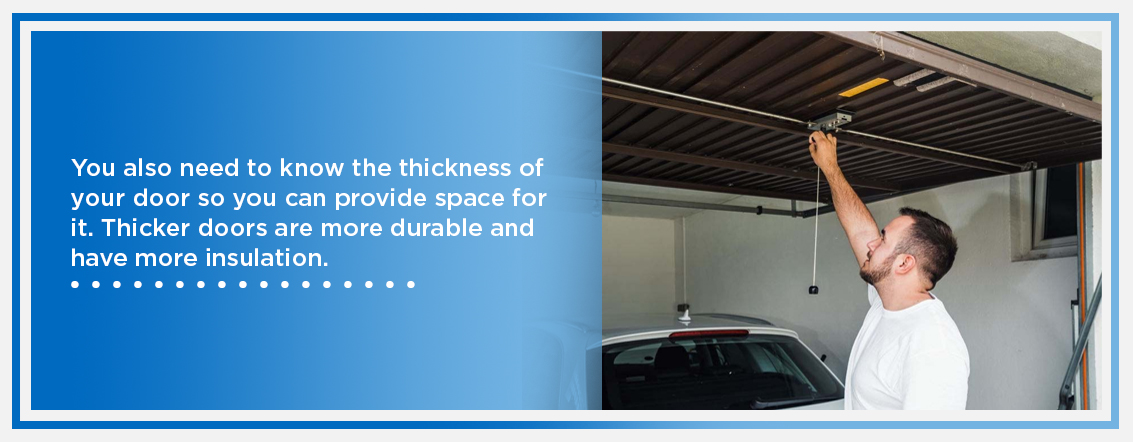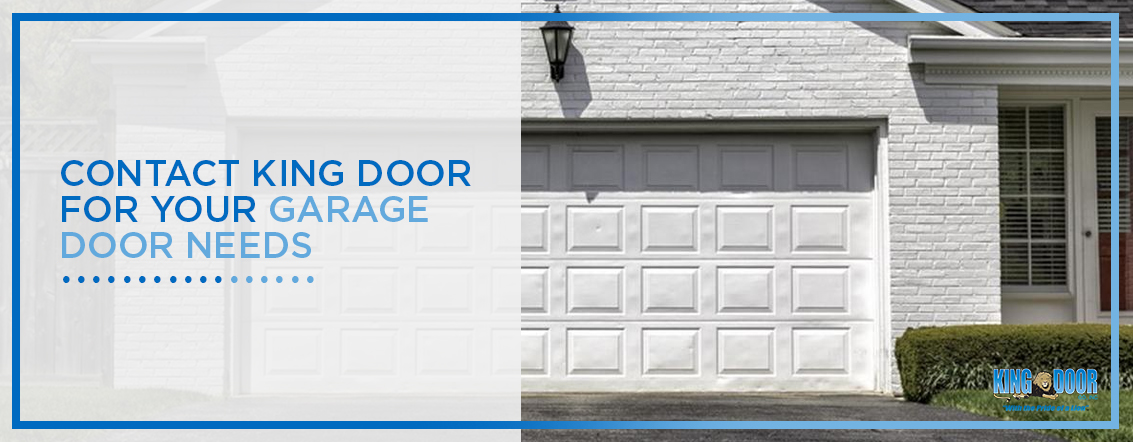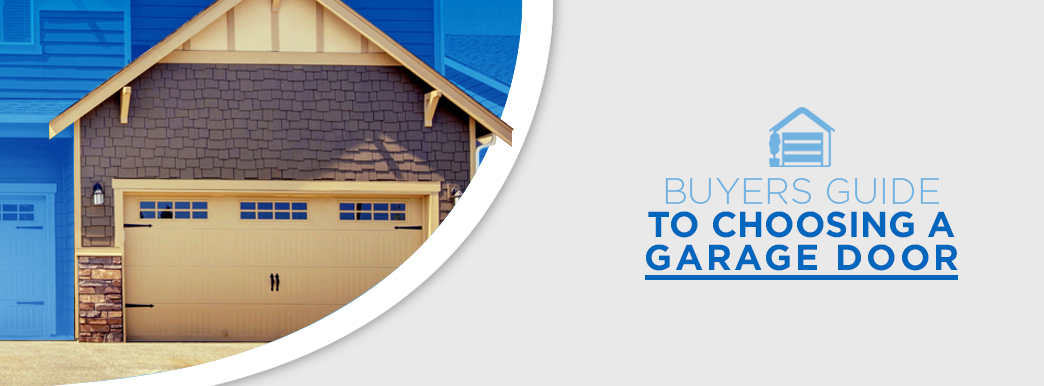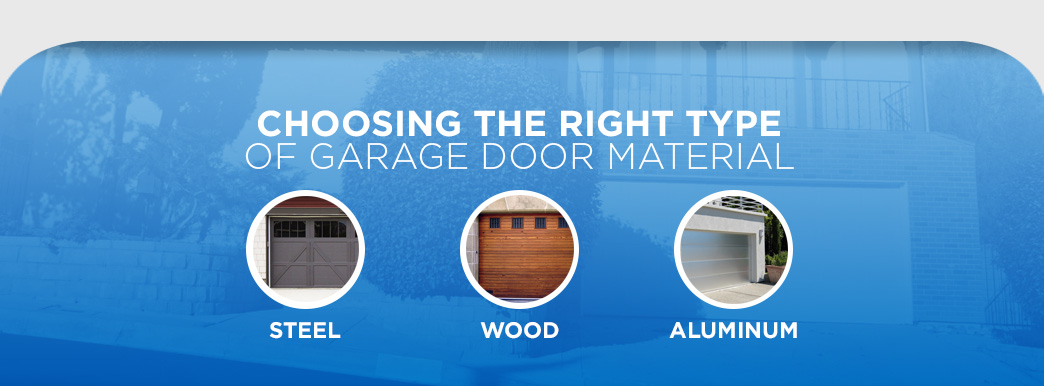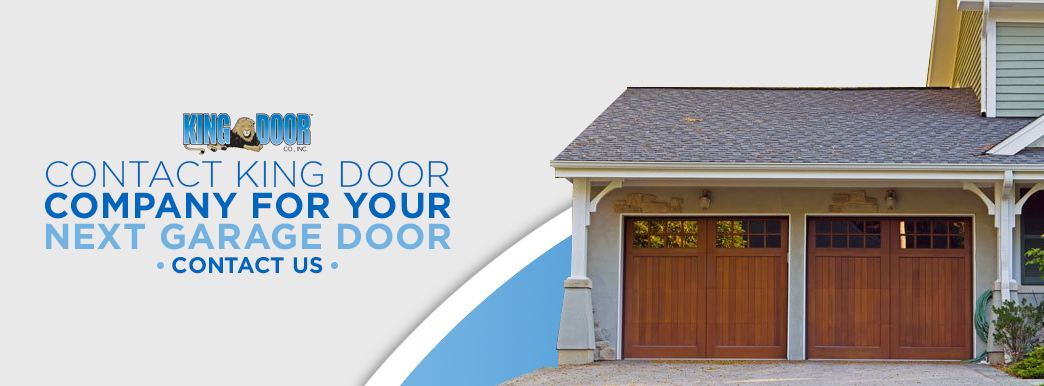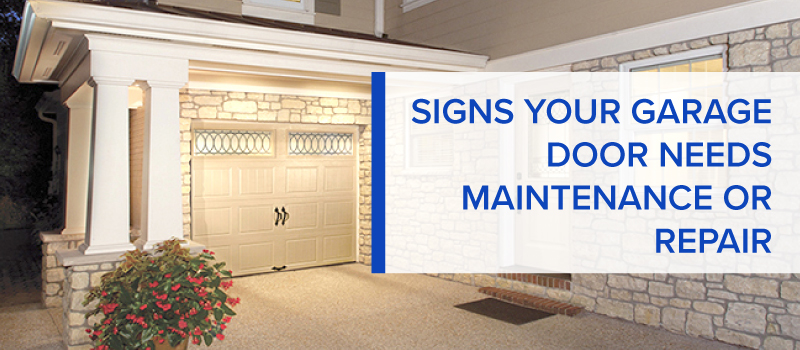How to Manually Open and Close Your Garage Door
Your automatic garage door provides you with convenience and protection. But what happens if you can’t open your door automatically? You don’t need to feel like you’re shut out from your garage. If you know how to manually open and close a garage door, you can save yourself the hassle of dealing with a door that won’t open and the security risk of a door that won’t shut.
Need Help? Contact King Door Now
Manually lifting your garage door can solve some issues, but you should troubleshoot your situation first. Trying to manually open a garage door that is damaged can cause more damage to the door and puts you and others at risk of injury. If you’re having trouble opening your garage door, you may have:
- A broken spring
- Broken or loose door cables
- A door that has dislodged off its track
- Experienced a power outage
- A malfunctioning garage door remote
You will need to manually lift your garage door if you have experienced the last two reasons for a malfunctioning door. Any loss of power to an automatic door and any technical issues with a remote mean you’ll have to open your garage door manually. You could also have to lift the door manually in an emergency where sensors malfunction and you need to lift the door off something. In non-emergency situations, you may simply want to disengage your garage door opener when you’re going away on vacation. No matter your reason, you’ll want to know how to manually open your garage door by detaching the automatic opener.
Using a Garage Door Emergency Release Cord
You aren’t out of luck if you can’t get your garage door to open at the push of a button. Garage doors come with an emergency release cord to use in the above situations. The cord allows you to disengage your garage door from the opener, allowing you to open it manually. The garage door manual open emergency release cord is usually a red rope with a red pull handle, and you will find it on the opener rail near your door. To use the cord, follow these steps:
- Locate and pull the cord: Holding the handle at the end of the cord, pull until the release lever locks. Pulling the cord detaches the garage door from the opener and allows it to open manually. Typically, you have to pull the cord straight down or slightly away from the door to disengage the opener. Since the lever is spring-loaded, you will have to pull with enough force to lock it into place.
- Manually lift the garage door: Using both hands and help from others if you need it, raise the garage door. If you cannot open it, check that you’ve correctly detached the lever and try again. Do not try to force the door open if there is resistance. Forcing the door could lead to injury, and it may be a sign that your door is damaged.
- Secure the door: Be sure not to let go of the door until it is secure. Springs on your garage door may hold it in place, so it should stay open on its own when you manually operate it. Your door may have defective springs or another issue if it can’t stay open. While you can prop it open or have others hold it long enough to take your car or other items out of the garage, you should contact a professional and avoid operating your door if you notice any issues.
While opening your garage door manually is straightforward with the steps above, you should still proceed carefully. When you have to use the emergency release cord of your garage door, use caution and remember these warnings:
- If you’re releasing an open door, clear the area in case the door closes suddenly
- Try to ensure that the garage door is closed before you work with the door in any way
- Have others help you if you can’t lift the weight of a closed door
- Prop open the door with something sturdy or have others hold the door if it doesn’t stay open on its own
After manually opening and closing your garage door, remember to lock it manually if you’re leaving. The manual lock allows you to secure your garage door and everything in your garage, even in a power outage. Remember to unlock it before trying to open it again, manually or automatically. Check that the door’s manual lock is not in use if you’re having trouble opening your garage door.
Once you’ve used the emergency release cord of your garage door, you’ll have to ensure that you can use your automatic opener again. To do this, you should know how to reattach the garage door opener.
Re-Engaging Your Garage Door Opener After Using the Emergency Release Cord
Since pulling the emergency release cord disengages your garage door opener for manual operation, you’ll have to re-engage it if you’d like to use your automatic opener. Get that convenience back by learning how to reattach your garage door opener. Whether you need to re-engage a LiftMaster garage door opener or another brand, follow these steps:
- Be sure the door is closed: Your door needs to be closed before you can reset your garage door after a power outage. If it’s open, you risk having the garage door crash down, which puts you and others at risk for injury. The force of the garage door closing may also break the door, any glass windows in it or the structure of your garage itself.
- Try pressing the appropriate buttons: Push the open button on your garage door remote, then press the close button if your remote has separate buttons for opening and closing. Your garage mechanism may reattach itself. If the remote doesn’t work, try the next step.
- Manually open LiftMaster garage door: You can manually slide the door along the track if your power is still out or your remote doesn’t work. With either this or the previous method, you should hear a click as the door opener re-engages.
- Don’t interfere with the opener: Allow the door to function without interference so that the opener reattaches properly. Listen for the click as you open and close the garage door. You may have to pull the emergency release cord toward the door to reconnect the arm if it doesn’t automatically connect to the trolley.
- Test that your opener works: Use your remote to test that your garage door can open and close automatically. If you’re still having issues, check that the release cord has connected the lever to your opener and try the above steps again. You may have to contact a professional if your garage door does not re-engage with the opener after you’ve used the emergency release cord.
Re-engaging the garage door opener is an easy step to forget after using the emergency release cord. If you cannot open your garage automatically after a power outage or other incident that required you to release the door, you may have forgotten to reset the garage door opener.
Remember to proceed carefully as you reattach the door to the opener and only work with a door that is already shut. If your garage door is stuck in the open position, call a professional to assist you so you don’t risk damage to your property or harm to yourself.
What to Do If Your Emergency Release Cord Breaks
Your garage door needs to have functioning parts for everything to work correctly, including the emergency release cord. If your garage door emergency release cord is broken, you will be left with a door that can’t function manually. To save yourself in the event of a future power outage or emergency, you’ll want to maintain your emergency release cord and check that it isn’t damaged. Damage can include:
- A broken or cracked handle
- Rust or corrosion on either the mechanism or the springs
- A frayed or rotted release cord
You may have one of the problems above if your garage door’s manual release is not working. Problems with the spring or other aspects of the mechanism are dangerous to repair yourself, even if you are a regular DIYer. Call in a professional to fix the door unless the only problem you notice is a broken release cord or handle.
If the cord is the only part of the mechanism that has broken, you can replace it. You won’t want to pull on a frayed, ripped or shorter cord or a cracked handle to be able to open your garage door manually, so to replace or install the cord and handle, follow these steps:
- Remove the old cord: Cut out or untie the damaged cord so you can remove it from the lever and make room for the new cord.
- Feed one end of the cord through the handle: Since the handle allows you to grab the cord and pull it, this will be on the end that hangs down from the mechanism. If you’re having trouble threading the cord, wrap tape around it to create an end that is narrow and easier to feed through.
- Secure the cord with a knot: Tie a simple knot on the end that you fed through the handle to ensure it stays on the cord.
- Thread the other end through the mechanism: The emergency release will have a spot that the old cord was fed through, which will most likely look like a hole at the end of a small lever. Thread the end of the cord without the handle through this spot on the lever.
- Tie off the cord: Be sure that the handle of the cord is at least six feet above the ground to provide your car the appropriate clearance. Then, on the end you fed through the lever, tie a knot to secure it.
- Trim excess: Trim any excess cord and seal the end of the cord by heating it with a lighter. Sealing the cord helps ensure that it does not fray.
You don’t want to get caught in an emergency without the release cord. Ensure that you have installed the cord, you know how to use it and you regularly check that it is functioning. You can always call a professional if you’re unsure about your garage door release cord or any aspect of the mechanism.
When to Contact a Professional for Garage Door Help
If anything seems off about your garage door, don’t take the risk of trying to operate it yourself. Whether or not you’ve operated the door manually, you may notice a problem with your door after some time. You may not even be able to open your door manually if you have a damaged door or opener. Some issues that require a professional’s help include:
- The door itself is broken
- Broken or damaged springs
- Any misaligned cable
- A crooked door
- The door is off the rail
- A damaged motor in your opener
View Our Garage Door Repair Services
Those problems can come from any range of sources. Your garage door may be old or damaged by repetitive use or a storm. Be sure to watch for any changes in how your garage door operates and check your system for damage after a storm. Any of the above problems could lead to a dangerous situation if you don’t contact a professional for help, so keep your garage secure if you notice any of these issues. Keep an eye and ear out for these signs of an issue:
- The door is making a lot of noise.
- You can’t manually open garage door.
- There is a delay when the door responds to the remote.
- The door appears crooked, dented or damaged.
- The garage door’s manual release is not working.
Avoid opening or closing your garage door if you can after noticing any of the above. Limit how often you use the door until a professional can come in and evaluate the mechanism. Some basic maintenance — such as cleaning tracks and rails and tightening hardware— can help prevent major problems, but be sure to call a professional in if you aren’t sure how to solve an issue or if that issue is mechanical.
Contact King Door for Garage Door Repairs
If you cannot open your garage door or if you’d like to update your door, contact us at King Door. Schedule our services or request an estimate for your garage door replacement or repair. Find a new garage door opener with us, and our highly-trained technicians will be happy to install it. If you want to update your door to suit the style of your home, we offer a wide selection of garage doors from modern to classic. No matter what you’re looking for, we’re happy to help you find the product that suits your needs and keeps you safe.
How to Reset a myQ Garage Door Opener
Your myQ garage door opener is a convenient tool that helps you control several aspects of your garage door remotely. Like many homeowners, you likely rely on this device to:
- Determine when your garage door has been opened or closed.
- Monitor activity around the door’s vicinity.
- Know if the door has been locked.
When your door opener experiences glitches, you want to restore smooth performance so you can continue enjoying all its benefits. Resetting a myQ garage door can refresh the settings and give it a new start. It’s essential to complete a factory reset only when necessary and follow all the instructions.
Learn how to reset your myQ garage door opener in this guide, and consider hiring a professional to assist you.
What Does a myQ Factory Reset Do?
A reset removes all previous data and settings from the myQ Smart Garage Hub, meaning you’ll need to configure the entire system from scratch. There’s a difference between a factory reset and a Wi-Fi erase. A factory reset erases all the information as if it were a new device. A myQ reset:
- Erases all keyless entry codes and remote controls.
- Removes your myQ Smart Garage Hub from the current account.
- Deletes all the door sensors.
Conversely, erasing the Wi-Fi removes the Wi-Fi connection from your garage opener — it doesn’t erase the entire system. A Wi-Fi erase removes the myQ door opener system from the current Wi-Fi, allowing you to reset the Wi-Fi settings on your Smart Garage Hub.
Reasons to Perform a Factory or Wi-Fi Reset
Here are some possible reasons for a factory reset:
- You’re moving your garage opener to a new myQ account and need to remove it from the current one.
- You’re experiencing constant connectivity issues.
- You’ve switched door opener brands and need to add the new device.
A Wi-Fi erase may be necessary if:
- You’re having persistent connection issues.
- You’ve migrated to another Wi-Fi provider.
Obtaining help from a professional can give you swift, expert guidance and peace of mind.
How to Reset Your myQ Garage Door Opener
Performing a factory reset deletes all previous information on your myQ account, so it’s crucial to follow the guidelines correctly. When done successfully, you can avoid further complications, such as error codes that require additional troubleshooting. An effective factory reset can also avert other difficulties, such as limiting or blocking access to your garage door or rendering it inoperable.
A professional can help you resolve any troubleshooting issues with your myQ account and garage opener, restoring optimal performance. Professional assistance is especially helpful when:
- You use your garage often.
- Safety and remote surveillance are paramount.
Factory Resetting for a myQ Garage Door Opener
Follow these instructions and the manufacturer’s guidelines, keeping in mind that the original company’s instructions trump all other information. When performing a reset, it’s vital to listen for beeps, look out for flashing lights and note how quickly these happen in succession.
Due to the complex nature of a myQ garage opener reset, we recommend hiring an expert to guide you through the following steps:
- Find the LEARN button: Locate the yellow LEARN button on the Wi-Fi garage door opening device. If your opener is against a wall, the LEARN button is underneath the front cover. Lift the cover to find the button.
- Locate the antenna wire: Where your garage opener is mounted to the ceiling, look for a yellow antenna wire that hangs on the side where the LEARN button is. The button should be behind or on the side of the motor.
- Hold down the LEARN button: Once you’ve found the wire, press the LEARN button on the door opener. Hold it for six to eight seconds until the LEARN LED goes off.
- Repeat: Remove your finger and immediately press the LEARN button again. Hold the button until the LEARN LED goes out.
- Press a third time: Release your finger and immediately push the button a third time until the LEARN LED goes out again. Listen for three quick beeps. All your previous data should now be erased.
Factory Resetting for Wi-Fi
If you recently acquired new Wi-Fi, are experiencing connection issues or realized your current Wi-Fi has been compromised, it’s best to erase your Wi-Fi settings and restore them to factory default. Note that erasing the Wi-Fi settings and restoring it to default are not the same. Once you erase Wi-Fi settings, you can set up your Wi-Fi again.
Clearing it to factory settings will have the same outcomes as a factory reset. All remotes, keyless entries and door sensors will be removed. The device will also be cleared from the myQ account.
A professional can help you determine the best choice for your situation and what the outcome will mean for you. They can also help you decide when a Wi-Fi erase or factory default is necessary, such as if you suspect a Wi-Fi breach or another concern. Have a myQ specialist help with the following:
Erasing Wi-Fi settings:
- Locate the green LED and ensure it’s on or blinking.
- Find the settings button located on the hub, then press and hold it down.
- Wait for the blue light to start blinking while you’re holding down the button. You can then set up your new Wi-Fi.
Restoring Wi-Fi to factory settings:
- Locate the settings button on the Wi-Fi hub.
- Push and hold the button until the blue LED starts blinking.
- Release your finger. As the blue LED blinks, press and hold the settings button again.
- Wait for the blue light to pause, then watch for a blink or listen for a beep. Your Wi-Fi hub is now back to factory settings.
Reprogramming Your Garage Door After the Reset
Once the myQ garage opening system has been returned to factory default mode, you’ll need to reprogram it so you can start enjoying its convenient features again. Follow this guide for reprogramming:
- Install the myQ application on your smart device if you haven’t already.
- Connect the myQ Gateway to your home’s Wi-Fi and your myQ application.
- Integrate your garage opener with the myQ app.
- Program the garage opening device using the app.
- Test the system to ensure it’s working.
- Customize the settings on the app if necessary.
Contact King Door Company, Inc. for Effortless Resetting
Your myQ Smart Hub is vital in keeping your home’s garage safe and helping you manage your garage door effectively. It’s sometimes necessary to reset the myQ system and refresh your devices when your connectivity needs a reboot.
A swift, trouble-free reset with the help of a professional ensures you don’t lose vital time with an inoperable system. For myQ garage door resetting and all your other garage door needs, contact the experienced team at King Door Company, Inc.
Our innovative approach and impeccable customer care will ensure you receive unrivaled same-day service With the Pride of a Lion. Call us at 661-397-2744 or contact us online for more information. You can also book a service with us or request an estimate today.
Why Is My Garage Door Opening by Itself?
Your garage door is an unsung staple of your daily life. You expect it to work consistently and predictably — any deviation from the norm can interfere with your schedule. One rare issue that can occur is your garage door opening at random. There are a few reasons why a garage door might open on its own, many of which involve the opening mechanism’s physical condition or a possible obstruction.
Reasons for a Garage Door Opening by Itself
An irregularity within the garage door opener, controller or sensors could be why your garage door opens by itself in the middle of the night or other times of day. Here are some common reasons for a garage door opening by itself and how you can resolve each issue.
Faulty Circuit Board
Professional service required? Yes
The garage door opener features a circuit board that controls its electronic signals. The circuit board can suffer damage as a result of another electrical problem in your home. If your home experiences a power surge, excess electricity could flood your opener’s circuit board and activate the motor.
There are additional circuit boards in your garage door controllers. Problems like cracks and water damage can cause various issues, including random opener activation.
Contact your local garage door repair company if you suspect a faulty circuit board is the source of the problem. A professional has the tools and equipment needed to protect themselves and your equipment while working with a circuit board.
Storms
Professional service required? Yes
Storms can cause your garage door to open on its own, especially those involving lighting. A lighting strike could cause a power surge that activates your garage door opener or damages the circuit board to a degree that unpredictable behavior occurs.
The operational irregularity that the storm causes could be an isolated event, but it may also persist. Monitor your garage door opener for unpredictable behavior or physical damage after a storm to determine whether there is a lasting problem. Your local garage door professionals can further assess your opener and make the requisite repairs.
Stuck Button
Professional service required? No
The garage door may open on its own if the button on the fixed or remote controller jams. Your controller may accumulate various dirt, grime and debris over time. These foreign particles may lodge themselves between the opener’s exterior buttons and the interior mechanisms you engage by pressing them. Your remote control is more likely to stick due to increased exposure to dirt and sticky substances.
You may be able to repair a stuck button on your own by cleaning the controller. Use a disinfectant wipe to clean the controller’s exterior. To address dirt and debris inside the opener, open it using a small screwdriver or the disassembly method the manufacturer recommends. Wipe the components around the bottom clean. Only open and clean your controller if you are confident in your ability to put it back together correctly. Otherwise, seek professional assistance.
Interference From Another Remote
Professional service required? No
A garage door opener sends a wireless signal that connects it to your remote control. A nearby remote control could intercept the signal in some situations.
If you and your neighbor have the same garage door opener, they likely send an identical signal to the remote. Programming your remotes at the same time could cause one of you to connect to the other’s opener accidentally. While accidental interceptions are more common in older openers, the issue may still occur in modern models.
If you suspect your neighbor may be activating your garage door, ask them to test their remote. Have your neighbor activate their opener while you monitor yours to confirm or rule out the issue. You will need to reprogram your remote if you determine an accidental interception occurred.
Sensor Issues
Professional service required? No
One of the most common times a garage door will open by itself is immediately after you attempt to close it. The door will reach a certain point in its descent, then suddenly reverse its motion. The sensor is likely the reason for the opener’s operational switch.
As a safety mechanism, the sensor detects objects under the door to prevent damage — this is how your door knows not to close on you or your vehicle. For the sensor to work properly, there must be a clear path for the laser to travel from the device on one side of the door to the other.
Assess the area beneath your garage door to ensure there is nothing for the laser to detect. If the door still reverses during operation, the sensors may be dirty or misaligned.
Dirt covering the laser emitter or receiver will trick the sensor into thinking something is in the way. Similarly, knocking one of the devices off its axis will disrupt the connection between the devices and cause the door to reopen by itself.
To fix the issue, start by wiping the sensors clean. Then, if the door continues to reverse, adjust each sensor’s physical positioning until the laser and receiver meet again. Many sensors feature a small light that indicates proper alignment.
Damaged Wires
Professional service required? Yes
Garage door opening systems feature numerous wires that connect devices to the opener. Both the sensors and in-garage controller feature a hardwired connection. Damaging these wires could cause an array of issues, including unprompted opener activation.
The garage door’s various wires are thin, leaving them susceptible to damage. Gradual wear can damage the connection between devices. Alternatively, a single incident could sever a wire or disconnect it from either end of the device.
Call a garage door repair specialist to repair damaged wires in your garage to avoid danger or further damage.
Garage Door Repair Experts in Bakersfield, California
At King Door Company, Inc., we help homeowners and business owners understand and fix unusual garage door behavior, such as unprompted opening. Our experienced professionals are available for same-day service so that you can resume using your garage door as a dependable feature. We work with the pride of a lion, going to great lengths to ensure customer satisfaction.
Please contact us online for more on our garage door maintenance and repair services.
What Safety Features Should I Look for in High-Speed Doors?
When selecting the most efficient high-speed door for your business, safety features maximize secure operations and prevent accidents and injury.
Safety systems to look for include operation alerting systems and anti-collision sensors. Learn more about these features to have in your high-performance door.
The Importance of Safety for High-Performance Doors
Having efficient safety features in your high-speed door can help facilitate smooth operation while minimizing injury and damage.
When a high-speed door — also known as a high-performance door — is used frequently, being opened and closed hundreds of times daily, it can be easy to take operations for granted and neglect proper safety procedures. Adequate safety features can help prevent accidents such as:
- Entrapment
- Property and asset damage
- Cross-traffic accidents
- Contamination
Safety Features to Look for in High-Speed Doors
Depending on the nature of your facility, there are many more safety factors to note when choosing a high-performance door for your operations. Below is a list of safety features that address the common concerns in most industries.
- Anti-collision sensors: Sensors that detect movement or the presence of objects under and around the door. Detection results in the door automatically stopping or reversing. Systems that accomplish this include safety light curtains and photo-eye sensors, which ensure a secure operation for all personnel.
- Activation sensors: These sensors allow the hands-free operation of high-speed doors, preventing accidents and maintaining traffic patterns for smooth operation. Touchless activation systems can come in various forms, such as wave-to-open systems or motion-detecting automatic doors.
- Audio alert system: An audible alarm or pre-recorded message will play depending on the current operation of the high-speed door. This maximizes awareness to prevent traffic collisions.
- Light signaling devices: These accomplish the same goal as the audio alert system, using lights to indicate the door’s current operation. Using both audio alerts and light signaling can maximize awareness and safety in the perimeter of the high-speed door. Signaling lights can come in various device types, such as traffic lights, strobe lights and rotating lights.
Browse Our High-Speed Doors With Advanced Safety Features
At King Door Company, Inc., we supply and install modern overhead high-performance doors that come with advanced safety features for injury prevention and asset protection, including safety reversing systems and photo-eye sensors.
Explore our high-speed commercial door options for various industries, including cleanrooms, cold storage and pharmaceuticals.
Can High-Speed Doors Be Customized to Meet Specific Requirements?
High-speed doors, otherwise known as high-performance doors, should meet the specific requirements of your business. That’s why you can get a customized high-speed door solution based on your doorway measurements, electrical requirements and other crucial data points listed below. Find out more about how you can customize your high-speed commercial door for your needs.
What Are High-Speed Doors?
High-speed doors open and close quickly. The average speed of a high-performance door is 1 meter or 3.3 ft per second. They’re used in various industries, across industrial and commercial properties. You’d see them most commonly in manufacturing facilities, warehouses and food processing plants.
They’re built with high performance in mind, allowing for fast operations, frequent use and endurance in all environments. This is why high-speed doors are also referred to as high-performance doors.
These doors come in various styles depending on their primary purpose and the needs of the facilities. For example, high-speed doors can come in different materials such as fabric, metal and rubber. Customizations also allow for fire-, wind- and smoke-rated doors.
What Information Is Necessary to Customize Your High-Speed Door?
To get the most suitable high-speed door for your unique needs, installers and manufacturers will need information such as:
- The dimensions and installation space of your doorway: Knowing your doorway’s height, width and depth helps manufacturers fit the most suitable high-speed door for you. The measurements of the surrounding space of your doorway will determine the ideal positioning of necessary support structures for your door.
- Usage requirements and conditions: Disclose how you plan to use the high-speed door and how frequently. This will help suppliers provide the most suitable model for your needs. You also want to get the right material for your door, so knowing the average temperature and humidity levels of the facility is important for getting material that can withstand the environment in which the door operates.
- Power supply and wiring: Let your supplier know the power supply’s voltage requirements and the wiring’s location to ensure your high-speed door is appropriately connected and meets the electrical requirements for operation.
It’s also important to customize your door according to any special requirements, such as fire-proofing or static-proofing.
Get the Ideal High-Speed Commercial Door for Your Business at King Door Company, Inc.
Invest in quality, customized high-speed doors with King Door Company, Inc. We offer high-speed overhead doors for various purposes, including agriculture, cold storage, and food and beverage.
King Door Company, Inc. has been supplying, installing, maintaining and repairing commercial doors since 1985. We pride ourselves on the quality of our products and top-notch customer service. Learn more about our high-speed commercial door offerings.
Can Smart Garage Door Openers be Hacked?
Smart technology has transformed our houses and how we live in them. A smart home offers owners a more convenient way of life, which is exceptionally important for those with busy lifestyles.
Garage door openers use smart technology to control who can access your garage and when. With the simple push of a button, you can allow guests, delivery staff or repair professionals to enter your garage even if you are on the other side of the world. However, many homeowners’ concerns focus on safety rather than convenience.
How Smart Garage Door Openers Work
A smart garage door opener uses a wireless internet connection and sensors to allow you to control the opening and closing of the garage door remotely. Smart garage door opener systems include a garage door motor, belt rails and a transmitter. You can also modernize your existing overhead door with add-on accessories that include controllers and sensors that must be compatible with your current garage door.
Regardless of the option you choose, you can use an app or a website to control your garage door remote.
How Safe Are Smart Garage Door Openers?
The straightforward answer is that garage door openers, like any other technology, can be hacked, but having a smart garage door opener is much safer than not having one. With the right online security measures, a smart garage door opener is a secure and worthwhile investment.
Virtually any online platform and any service that relies on wireless technology may be susceptible to hacking. Still, you can rest assured that taking the same safety steps you would with all your other vital online accounts will secure your garage and give you peace of mind.
6 Ways to Keep Your Garage Door System Secure
Following these tips will help protect your accounts and your smart home:
- Only connect to the smart garage app using a secure internet connection.
- Choose a robust password for your app, and do not share it with anyone outside your immediate family. You should also change your password regularly.
- Enable multi-factor authentication whenever you can. Such authentication requires a one-time password or code to access apps or verify commands, such as opening the garage.
- Keep your apps and software updated.
- Always review your privacy settings and ensure you understand the app or website’s privacy policies.
- Opt for the most updated smart garage technology, which will be more immune to current hacking trends. It is also important to keep your garage doors and accessories updated to comply with state laws. In California, for example, you must have a battery backup for garage door openers, meaning an old garage door without a battery backup cannot be legally repaired.
Benefits of King Door Company, Inc. Smart Garage Door Openers
Quality smart garage door openers, including the Liftmaster Smart range available through King Door Company, Inc., take safety up a notch. Most openers are fitted with force-detection technology that activates door reversal when the sensors pick up on suspicious activity. Smart devices can boost security against potential intruders and help prevent injury, making these openers an excellent choice for families.
When you opt for quality Liftmaster Smart Garage Door Opener from King Door Company, Inc., you enjoy more advantages:
- Quality service from passionate professionals who care about your convenience and safety
- Installations, repairs and replacements performed by knowledgeable technicians who arrive in marked vehicles and dressed in uniform
- Fast response times and 24-hour emergency services
Trusted Garage Door Openers from King Door Company, Inc.
At King Door Company, we strive to meet your needs regarding the safety and convenience of your garage and home. Since 1985, we have emphasized providing our customers in California with exceptional products, parts and services. Our team offers commercial and residential garage doors and accessories and is the go-to source for reliable garage door installations and repairs in Bakersfield.
Contact us today to speak to a friendly representative about our smart garage door openers or repairs and replacements.
What Is a Security Grille?
Businesses must take extra precautions to keep their property secure. After all, you have to protect your premises and assets from potential intruders or burglaries. You can do this with a durable security grille. Security grilles are highly secure mechanical gates made with various strong metals. King Door Company, Inc. is here to provide information on security grilles, helping you decide on suitable protection for your property.
What Is the Purpose of a Security Grille?
Security grilles will serve your business well if you own a company that stores valuable assets on the premises. The primary purpose of a security grille is protection. These gates are robust and reliable, providing additional safety for business and residential properties.
You can install a security grille over any entry point as an extra measure of protection, bringing you peace of mind. The sturdy appearance of a security grille also acts as a visual deterrent for criminals since these gates are difficult to break through.
Are Security Grilles Worth It?
Most business owners will agree that security grilles are a worthwhile endeavor. Investing in a security grille decreases the risk of losing valuable assets or experiencing property damage due to theft or intruders. In addition to offering unmatched security to your property, they offer a range of other beneficial features, such as:
- Cost-efficiency: Although security grilles are robust and long-lasting, they’re also affordable, saving you money now and in the future. Additionally, security grilles require less maintenance than most other security shutters.
- Versatile designs: Choose between grilles with open panels, glazed panels, a straight-pattern grille or a brick-pattern grille, and select from various colors to complement your business. You can also decide on the way you operate your security grille since we offer an EZ lift option.
- Convenience: Security grilles are sturdy, but they are also easy to roll up. You don’t have to worry about struggling to maneuver these gates every day.
Get Your Security Grille From King Door Company, Inc.
Would you like to increase the security of your property? You can’t go wrong with our high-quality security grilles. We offer multiple models with varying designs and features to suit different applications. At King Door Company, Inc., we specialize in reliable garage doors and other secure installations.
We have a team of expert technicians who can guide you through choosing the right security grille and handle the installation seamlessly. You can count on us for same-day service and fast turnarounds. Contact us today for more information on our innovative security solutions.
Buyers Guide to Choosing the Best Garage Door Material
Your garage door is a reflection of your lifestyle and preferences. Whether you prefer a look that’s vintage, rustic, traditional, modern or anything else, your garage door will enhance that appearance. Finding a door that achieves this requires determining what material is best for your garage doors.
If you’re wondering which type of garage door is best, we’ve compiled a guide to help answer that question. Our guide will discuss garage door materials’ pros and cons, show a garage door quality comparison and help you decide how to choose the one best suited for your lifestyle.
What Is the Most Common Material for Garage Doors?
Steel is the most popular choice of material for garage doors, but that doesn’t mean it’s the best type of garage door for every home. Steel is flexible and low maintenance compared to other materials, and it’s a low-cost option. You can style these doors to match your home’s exterior, and you can paint steel easily.
Aluminum is also a very popular choice and shares a lot of the same qualities as steel doors. Aluminum is lighter than steel, making aluminum doors less durable and easier to dent than steel doors. You still have plenty of style options available for aluminum, including faux wood texture and finish.
7 Common Garage Door Materials
Although steel and aluminum are the most popular choices, there are other garage door materials to make your door. Each type has pros and cons and will impact the look of your home.
1. Steel Garage Doors
Steel garage doors are the most popular choice right now. Steel doesn’t warp, dismantle or crack, even in harsh weather conditions, making it a very low-maintenance option. Despite its durability, steel can fall prey to corrosion and rust. You can use a coating to galvanize steel to aid against rusting, but this can be more expensive than untreated steel.
Furthermore, steel doors are not natural insulators, so you will need to invest in some insulation if you want a warm garage that doesn’t let a lot of sound out. Insulation can also help to strengthen your door, making it more resistant to dents.
Pros of steel garage doors:
- Plenty of styles to choose from
- Affordable option
- Durable and lightweight
- Performs well in all climates
Cons of steel garage doors:
- Subject to corrosion
- Not a source of insulation
- Not resistant to all dents
- Scratches can rust
Steel is a popular choice because of its versatility, durability and maintenance requirements. However, it’s not without its flaws. You may decide on other options that would better suit your lifestyle.
2. Aluminum Garage Doors
Aluminum is another popular choice for garage doors. It is a cost-effective choice for many homeowners and still has a wide variety of styles and designs to choose from to enhance your home’s exterior. It is resistant to natural damage such as rust and corrosion.
These doors are also known for their low R-value, which measures thermal efficiency. The R-value refers to how well insulation keeps warm air from escaping. High R-value materials can trap a lot of warm air, while low R-value materials allow heat to escape easily.
Pros of aluminum garage doors:
- Naturally resistant to corrosion and rust
- Very customizable
- Low maintenance
- Lightweight
Cons of aluminum garage doors:
- Not fully waterproof
- Low R-Value
- Becomes softer in heat
- Not as resistant to dents
These doors are worth considering for their customization availability, especially considering they are a less expensive option.
Steel vs. Aluminum Garage Doors
Between steel and aluminum, steel is the more durable option. Because aluminum is lighter than steel, it is also less impact resistant. However, aluminum is rust and corrosion resistant, while you need to monitor steel for these potential damages. Aluminum is also less expensive.
Neither metal is a natural insulator, so you can expect to need foam padding or something similar to keep your space warm. However, steel doors are easier to insulate. You can raise the R-value of your garage by adding insulation, but this is still something to consider when deciding what door will best suit your lifestyle.
3. Glass Garage Doors
Glass garage doors are unique, beautiful and safer than you might think.
Tempered glass is a form of safety glass. It has a much higher impact strength and can be found in bulletproof glass, car windows and shower doors. You can also get frosted or tinted options that block people from seeing inside your garage while still providing ample light to an otherwise dark space.
Although it does have a lower impact strength than metal or wood, tempered glass is safer than standard glass. When it shatters, the pieces are much smaller and less sharp, making it less likely to cause injuries.
Pros of glass garage doors:
- Creates a modern appearance
- Availability to customize
- Low maintenance
- Ample natural light
Cons of glass garage doors:
- Lower impact strength
- Can smudge and gather dirt
- Costly, depending on the manufacturing process
- Not a natural insulator
Glass garage doors can give your home an elegant and sophisticated look, but you have to clean them to get rid of dirt, smears and smudges. They are great for homes located in areas that don’t experience harsh winter conditions, such as coastal regions.
4. Fiberglass Garage Doors
Fiberglass garage doors are a small segment of the market. Fiberglass is a composite material, and it differs from tempered glass in its composition. You can use foam insulation to warm your garage and block street noise while still having various style options to match your exterior.
Fiberglass is also commonly used for entry doors. If you opt to coordinate your entry door and garage door, you can ensure an elegant curb appeal that is still functional.
Pros of fiberglass garage doors:
- Low maintenance
- Corrosion and rust-resistant
- Plenty of design options
- Doesn’t contract or expand due to temperatures
Cons of fiberglass garaged doors:
- Susceptible to wind damage
- Material underneath can yellow
- Wind can cause irritating noises
- Must be replaced if damaged
Similar to tempered glass, fiberglass garage doors are great in coastal regions and other warm locations. If you live somewhere that experiences harsh winter conditions or strong and frequent winds, other options may better suit your lifestyle.
Fiberglass vs. Steel Garage Doors
Fiberglass can insulate your garage much easier than steel, especially when you pair it with foam padding. However, if your garage door gets a lot of direct exposure from the sun, you’ll have to monitor your fiberglass door for signs of yellowing color or cracks with age. Furthermore, you cannot repair a fiberglass door. While you or a professional can fix minor damages in steel doors, you need to have a professional replace a fiberglass door when damaged.
Fiberglass won’t corrode or rust the way steel will, but it is more brittle. Due to its composition, fiberglass is much less resistant to dents and damage than steel. If you live in an area that does not experience harsh winds or severe rain, fiberglass is still a great option.
5. Wood Garage Doors
Wood garage doors are natural insulators that can accomplish a beautiful and rustic look. This type of garage door will give you a genuine, classic and authentic feel. These doors are easily customizable, making them an excellent option for any homeowner wanting a unique design or look.
The timeless look of these doors is not without its downsides. In wet climates, wood can become prone to rotting or warping. In some temperatures, wood also expands and contracts, which can cause your door to swell. Wooden garage doors need to be finished and maintained regularly. The cost of maintaining your door can quickly overstep the elegant beauty it brings to your home.
Pros of wood garage doors:
- Natural insulator
- Plenty of styles and designs
- Rustic and beautiful look
- Strong performance and rugged feel
Cons of wood garage doors:
- Heavier than other alternatives
- Needs to be maintained regularly
- Susceptible to warping, rotting or swelling
- Cracking finishes due to expanding and contracting
The first garage doors were made out of wood, and today these garages can give a traditional look to any home. Older homes and those with classic architecture can benefit from a beautiful rustic garage door. However, in areas prone to a lot of rain, other materials may be a more suitable option. Either way, you should expect to reseal, resand and repair your door every several years.
Wood vs. Steel Garage Doors
Steel has better energy conservation, but wood is a better insulator. Scratches and dents do not appear as clearly on wood doors as on other materials and metals. You can add more unique details to wood doors compared to steel. However, it costs more to produce wood doors because they cannot be crafted easily or quickly.
Another big difference between wood and steel doors is the level of maintenance required. Steel is relatively low maintenance, but you need to monitor it for rust and corrosion. On the other hand, wood can become prone to chipping, swelling, rotting and warping. You have to give wood doors more attention and be prepared to spend more on repairs and preventative damage measures.
6. Wood Composite Garage Doors
Wood composite is a blend of plastic, wood fiber and a binding agent. A composite garage door is a mixture of materials that can simulate natural wood. These doors are also referred to as faux wood garage doors. These doors are less expensive, lighter, require less maintenance and have a more straightforward installation process than real wood doors while still giving a beautiful look.
Many homeowners prefer real wood doors when their home faces the street to increase curb appeal and resale value. Although you may not see as many opportunities for customization in faux wood doors, you can use them to achieve a traditional or modern look, and you’ll receive them much sooner.
Pros of composite garage doors:
- Low maintenance
- Durable
- Great in any climate
- Easier installation than natural wood
Cons of composite garage doors:
- Heavy compared to other materials
- Doesn’t always precisely model natural wood
- Can crack after a while
- Paint can wear off
Wood composite doors are more durable than traditional wooden ones. They’re perfect in any climate because they are less susceptible to moisture, and the sun, wind and humidity won’t damage them. Although you may not see as many customization options compared to traditional wooden doors, you’ll receive your door sooner and feel secure in its performance for the years to come.
Metal vs. Wood Garage Doors
For the look of natural wood and the durability of a metal garage door, faux wood doors are a great middle ground. While real wood is susceptible to rotting, splitting and various other forms of natural damage, faux wood takes properties from its metal. Although you will experience different forms of age and wear, most of them are easier to fix. For example, rust is much easier to fix than rotting wood. You can usually sand other damages like scratches out of real wood doors, while those same damages in metal or composite doors will need repairs for the same issue.
Due to their composition, faux wood doors are heavier than other materials but lighter than real wood. Furthermore, the installation process for metal and composite doors is much more straightforward than for real wood, making the up-front cost much less. However, real wood is a natural insulator. If you want your garage to be warm, you’ll have to invest in some kind of insulation for a metal or composite door.
7. Vinyl Garage Doors
Vinyl is a synthetic plastic that can be made rigid or flexible. A vinyl garage door doesn’t contain any wood like a composite door. Vinyl doors are an excellent noise insulator, though they don’t insulate heat. They are also highly resistant to damage, and scratches are much less noticeable. They are rust-proof and won’t rot or swell.
Once you choose your vinyl color, there’s not much opportunity for change. Although you can paint it, it’s challenging to do so and is not typically recommended. They can also become brittle in colder temperatures, making them more likely to crack if impacted. However, they are an excellent choice for those in coastal regions because they are resistant to wind, sand and salt air. These doors typically have a finish that protects the door against UV rays, helping to keep the color from fading.
Some pros of vinyl garage doors:
- Resistant to splintering and splitting
- Durable
- Resistant to rust
- Low maintenance
Cons of vinyl garage doors:
- Difficult to be repainted
- Can crack upon impact in cold temperatures
- Not as many customization options
- Dark paint fades easier
A light-colored vinyl garage door can be great for those in coastal regions due to its ability to perform in humid locations. Although they are durable and a great investment, you can’t always get the exact look you want. If you want a dark color or prefer your door to look like wood, you may want to revisit the other options.
Steel vs. Vinyl Garage Doors
Steel is prone to dents and dings, but these damages are hardly noticeable on vinyl doors. Unlike steel, vinyl is also resistant to rust. Vinyl doors tend to be more expensive than steel doors. However, their ability to hold up against damages may save you money in the long run. Neither type is a natural insulator, so either option will require padding or something else to keep your garage warm, although vinyl is a good insulator for sound.
There are fewer customization options with vinyl compared to steel. While you can still customize your panels and windows, you only get one vinyl color, and you can’t accomplish a wood look with vinyl. Both types are lightweight and don’t require as much strain on your internal system.
Choosing the Right Material for Your Garage Door
By now, you probably see the appeal of several types of garage doors, but the best garage door is the one that best fits your lifestyle. You want to ensure a beautiful look that fits all your needs and only requires the maintenance you’re able to give it.
Here are the general topics you should think about for your garage door material comparison:
- Consider the environment: You want to first consider where you live. If you get a lot of rain, you’ll have to prepare for rust in steel doors and rotting in wood doors. Harsh winds can cause glass or fiberglass doors to rattle or crack.
- Set your budget: It’s a good idea to determine your price range early on in the process. Wood tends to be the most expensive material because they are not easy to make. If you want a wood look, set your sights on a composite or metal door that you can customize to look the way you want it.
- Decide on insulation: Wood is the only natural insulator. If you want a different material, you’ll need foam padding or some other form of insulation to keep your garage warm. Fiberglass and glass doors can brighten up your garage and, in turn, allow some light to warm up your space, but they may not be enough to match your needs.
- Think about damages: If you have children or neighbors who like to play outside, you should evaluate what kind of damages you might encounter and how you would fix them. On vinyl, scratches and dings are hardly noticeable. You can easily sand some damage out of wood. On metal or composite doors, even minor damages are apparent and will likely require repair.
- Imagine your design: You want your door to be functional and beautiful. You might love the durability of vinyl, but if you don’t like the color options, you should keep looking for that perfect door. Furthermore, if you love the natural wood look but can’t keep up on the repairs, you may want to consider a wood composite door.
- Evaluate your panels: Going hand-in-hand with your design, you want to consider whether you want a single panel or a sectional garage. There are multiple types of sectional garage doors. However, older homes are typically better suited for single-panel doors. If you have a traditional home, you may want to opt for a wood or wood composite single-panel door rather than a metal sectional door.
If you’re still unsure what door is best for you, consult a professional who will be able to ask you questions about your day-to-day life that may impact what door type is ideal. They’ll also remind you of the pros and cons of the options you’re considering and offer insight you may not have considered. Choosing the perfect garage door can be simple and easy with the right help.
Contact King Door Company, Inc. Today for a New Garage Door
King Door Company, Inc. has been in business since 1985 and operating for over 35 years. We know all about what’s new and upcoming in the industry, and we always share that knowledge with you. We work with the pride of a lion to ensure you get outstanding service while only using materials and products backed by proven manufacturers to ensure top-quality installation.
Our team is proud of the service and quality we offer. We offer same-day service and 24-hour emergency repair. Our team can complete most of our services on the same day because we value your time. Our technicians are highly-trained professionals who will always show up with everything they need for your service.
Contact us to schedule your garage door installation and let us transform your home.
Garage Door Repair: Why You Shouldn’t DIY
Garage Door Repair: Why You Shouldn’t DIY
Whether your garage door is making a strange sound, not opening right or is showing signs of wear or damage, it’s in need of repair. And with how essential your garage door is in your daily life, you want to get it functioning right away.
No matter the issue, many people will want to save some money and wonder how to repair a garage door themselves. This is a bad idea, as garage door systems are often highly complex and have many moving parts, making repair difficult for people who do not have expertise with these systems. Garage door repair is not necessarily the safest do-it-yourself (DIY) task, as there are many dangers associated with it.
In the worst cases, the repercussions of DIY garage door repair can even be fatal. Understand the dangers of DIY garage door repair and why you should save time, money and a lot of hassle by contacting a professional to do your garage door repair.
5 Reasons Why DIY Garage Door Repair Is a Bad Idea
From you and your family’s safety to your money, time and the state of your garage, there’s a lot on the line with garage door repairs. Here’s why a garage door DIY repair is not a good idea:
1. You May Cause Extra Damage
Taking on a garage door repair by yourself dramatically increases your chances of using the incorrect part, tool or process for the repair. By using the wrong part, wrong tool or wrong method to fix the garage door, you can cause more damage to the door in addition to what you are already trying to fix.
Attempting to repair your garage door yourself with minimal industry experience can cause damage to any items inside the garage if the door breaks during the repair. More damage can only lead to one thing — more money spent on repairs. And in worst-case scenarios, you could harm yourself or your household members.
2. You Probably Do Not Have the Right Tools
Repairing a garage door often requires specialized components and specific tools, without which someone cannot complete the repair correctly. More often than not, you cannot find these tools inside your typical home toolbox, leading to one of two options. You could shop for and buy the tools you need, but then you have just spent a decent bit of money on tools you used once and may never use again.
Another option is trying to adapt the tools you currently have to the tools needed for the job. We do not recommend this option at all, as using the wrong tools or using tools incorrectly can further damage your door, destroy your tools and possibly cause injury.
3. You Could Forfeit Your Warranty
Many newly purchased garage doors come with warranty programs that will help cover the cost of repairs or replacements anytime within a specific time frame after the date of purchase. Having a warranty on your garage door can be a huge help financially if the door breaks within that period. But not many people know what happens to the warranty as soon as you attempt to do a DIY garage door replacement or repair work on the door.
Once you have tried a DIY repair on your garage door, your warranty becomes null and void, as many warranties specify that they do not cover any aftermarket changes made to the product. Breaking the warranty by trying to fix a problem yourself may end up costing you money in the long run, especially if there was still a decent bit of time left before the warranty ran out.
4. You Might Fix the Wrong Problem
Without an advanced understanding of garage door systems, trying to repair the door yourself can lead to a trial-and-error-centered process, often causing you only to fix the symptoms of the problem or the wrong problem entirely. The discrepancies between fixing the effects or symptoms of a problem and fixing the actual problem can be hard to spot with an untrained eye.
Just fixing the symptoms means the real issue still exists and will come back eventually. Like fixing the wrong problem, only solving the symptoms will lead to spending more money down the road once the problem rises again.
5. You Could Get Hurt
Garage doors and garage door repairs are more dangerous than you would think. Between the door’s weight, height and many moving parts, there are many possible ways an untrained person can injure themselves during the repair process.
Why Are Garage Doors Dangerous?
Garage doors are extremely heavy and can weigh upwards of a few hundred pounds. These doors are then supported or lifted using heavy-duty springs made to withstand the tension put on them by the door’s weight. Repairing the door incorrectly or improperly can lead the door or one of its many parts to break, causing horrible consequences.
Here’s what makes garage doors dangerous and the possible physical repercussions of DIY repair.
The Door Can Fall
One of the most obvious consequences is that if the door falls during repair, it could land on and seriously injure you, a family member, a pet or someone you know. A garage door weighs several hundred pounds and would fall from around 6-10 feet to the ground, only adding to the force someone or something would feel if the door were to land on them.
In a best-case scenario, the door would fall with no interruptions and only break itself. Still, it can also crack your garage floor or damage personal belongings inside or directly outside your garage.
The Springs Are Under High Tension
Torsion springs are another hazardous but relatively unknown part of a garage door system. These springs are designed and used to lift and keep the doors off the ground. Garage door springs are tightly wound and full of tension or stored energy at any given point in time.
If one were to break or release, garage door springs become dangerous due to the stored energy. The exit velocity of the spring can lead to severe or even fatal injuries to anyone who is struck by one, and a spring’s path is unpredictable. The damages include anywhere from getting caught in hair or causing broken bones to internal bleeding and head trauma.
Is It Safe to Repair a Garage Door Yourself?
The short answer? No. Attempting DIY garage door repair is very dangerous on a few different fronts, especially if you do not have a high-level understanding of garage doors and how they work:
- Physically: DIY garage door repair is definitely not safe, as you can seriously injure yourself or someone helping you if you attempt to fix a garage door with no professional help.
- Financially: While fixing your door yourself may be cheaper initially than calling a professional to come and fix it, doing the original repair wrong is much more likely when the project is DIY. If not done correctly, the door may require even more repairs sooner rather than later, costing you even more money to fix.
Contact King Door for Professional Garage Door Repairs Today
Whether you consider yourself handy or not, make sure you contact the professionals the next time your garage door needs repairs.
Here at King Door Company, we pride ourselves on the quality and safety measures our crew takes to ensure the job is done the right way the first time. Our technicians have a wide variety of tools in their trucks at all times, meaning they are more likely to finish their repair on the first trip, equating to greater convenience and lower labor costs for our customers.
Does your garage door need to be repaired, or do you need other residential garage door services? Save the hassle, danger and stress of doing it yourself. Get in contact with King Door Company today either by phone at (661) 397-2744 or online by requesting a service or requesting an estimate.
Why Is My Garage Door Making Noises?
Why Is My Garage Door Making Noises?
When garage doors are working correctly, it’s common for us to take them for granted. They open when we tell them to, close when we want and keep our cars and equipment at a comfortable temperature. It’s only when something goes wrong that we discover their importance.
One common issue is a garage door making loud noises. A well-installed overhead door without issues will be fairly quiet, but if it’s banging, rumbling or rattling, some problems could be present.
Here are some reasons your garage door could be making those noises and some effective ways to fix them.
What Causes a Noisy Garage Door?
One of the most challenging parts of dealing with a noisy garage door is identifying the source of the sound. If you’re unfamiliar with the door’s parts and structure, this process can be more involved. But there are some common problems that can explain why your garage door is so loud, and with a little knowledge, you might be able to figure out what your issue is.
Loose Nuts and Bolts
Your garage door comprises an extensive system of parts working together to power the mechanism and ensure its effectiveness. Sometimes, these parts might become loose and create that extra noise you’re hearing. Loose nuts and bolts can vibrate or cause screeching noises as the garage door opens and closes.
Misaligned Tracks
A loud, rubbing or screeching garage door that’s having trouble opening and closing could result from misaligned tracks. Your door runs through these tracks, so if they are misaligned or become damaged somehow, they can pose a major problem to your door’s basic function. Check for any loose screws and parts that might be contributing to this issue.
Poor Lubrication
Another common cause of a loud garage door is poor lubrication. After a long time, worn parts of your garage door will start to rub and grind against each other, explaining why your door is so loud when it’s opening. Luckily, this is a fairly easy problem to fix. Stop by King Door Company and purchase the best recommended lubricant for your garage door. We are located at 7450 District Blvd. Bakersfield, CA 93313 or call 661-397-2744
Lack of Balance
Your garage door relies on adequate balance to open and close properly. If this balance is changed somehow, it can cause the door to malfunction and lead to loud banging or scraping noises.
Old Age
Your door might simply be old, resulting in odd noises due to normal wear and tear. You can often fix the symptoms of aging with minor repairs or lubrication, but if the noises are incessant and require constant maintenance, you might want to look at getting a replacement.
Improper Installation
If a garage door begins making noises right after you get it, this could be a problem associated with how it was installed. A new garage door should be relatively quiet, but if you’re hearing banging or screeching from the start, this usually is a sign that something went wrong while it was being put in. Contact the company that installed your door to see if they can fix it, or reach out to a trusted, reliable service that can identify the problem and take care of those noises.
How to Quiet a Noisy Garage Door
If you’re able to identify the source of your garage door’s noises, you can start finding ways to solve the issue. Here are some common solutions to help you quiet your noisy garage door.
Use Lubrication
Poor lubrication is a common problem that can cause your door to make noise when opening. It’s common with older garage doors, as hardware can start to scrape. But this problem has a quick fix — you can lubricate roller extension-not rollers themselves, hinges and springs to combat rust and those annoying scraping noises.
Make sure you’re being careful — extension springs are often under heavy tension and could snap if mishandled. Consult a professional garage service for lubrication to ensure your safety. Also, make sure you’re using the right lubricant for your garage door.
Tighten Parts
If you identify some loose nuts and bolts, you can attempt to tighten these with a wrench. Be careful with this process as well — making them too tight could strip the screw holes.
If you’re confident in tightening them yourself, this is a fairly quick minor repair that can effectively quiet your garage door.
Make Repairs
Some garage repairs might require more than just a simple turn of a wrench, and if the noise persists after lubrication and tightening, there could be a larger problem at work. Your garage door might need repairs or replacements in several areas:
- Rollers: The guiding rails that allow your garage door to open and close are called rollers. If these become worn or damaged, they can cause loud grinding or screeching and trouble opening your door. If you notice your rollers are damaged, contact a door company to get them replaced by a professional or stop their location and purchase them and install them yourself.
- Springs: Garage doors use either extension or torsion springs to harness the power needed to open and close. If you notice that a spring is broken or damaged, it could be a potentially dangerous situation. To be on the safe side, always consult with a professional to get your springs replaced or repaired.
- Hinges: Garage door hinges are durable but sometimes may need repairs. You should try lubricating the hinges first, but if the noise doesn’t go away, you may need replacements.
- Chain: Your garage door chain system may need lubrication or could be loose. While you can lubricate it on your own, tightening the chain may warrant a service call.
If your garage door makes a loud noise when it’s opening, the problem may fall under one of these repairs. With the more major repairs listed here, it’s better to lean on the side of caution and find a trusted service to perform the job.
Schedule Regular Maintenance
Regular, scheduled maintenance can help you get ahead of potential problems before they happen. Instead of waking up one day to a screeching garage door, ensure you have a company on hand that can regularly check on the state of your door and keep it working effectively and quietly.
Find a Professional Service
When your garage door starts getting loud when closing, you know you need service. Sometimes one of the most challenging aspects is finding a professional garage door business you can trust if you don’t already have one. Luckily, King Door Company, Inc. has just the service you need.
Contact King Door for Garage Door Services Today
Leave your major garage door issues up to the professionals to ensure your safety and save time. King Door serves anyone with garage door needs. With over 35 years in the industry, we’re dedicated to providing the highest quality products and best service to our customers. We offer same-day service so that you won’t have to wait to get your repairs done. Contact us today to schedule service for your overhead door!
Why Is My Garage Door Opener Not Working?
An automatic garage door opener allows you to conveniently open your garage door with only the press of a button. But what do you do when your garage door won’t open? It could be a simple fix, like replacing the batteries on your remote or making sure the garage isn’t locked. However, for more severe issues, you should contact an expert technician, so you don’t get hurt. Use this guide to discover why your garage door won’t open or close.
Why Is My Electric Garage Door Not Opening?
Your electric garage door has several components that help it move, and if any of those parts don’t work, the whole system could get stuck. Try opening and closing the door both manually and automatically. If it doesn’t work, before checking the opener, turn off the automatic feature and inspect the system for loose or broken parts. Follow these garage door opener troubleshooting tips, depending on the problem you have with this system.
1. Garage Door Won’t Respond to the Remote
Here are some of the reasons why your garage door might not be responding to the remote:
- You’re out of range: If your remote doesn’t open or close the garage door, try moving closer to your house. It needs to connect to an antenna inside the garage, but it won’t if you’re too far away.
- Frequency interference: Along with being out of range, the antenna on the motor unit might not connect to your remote because something may be blocking the connection. Try straightening it out and checking it for damage. Some LED light bulbs could cause frequency interference, so if you have them, you can try removing them and then testing the remote.
- The remote needs new batteries: If your door works with the wall switch but not with the remote, you may need to change the batteries. Check the instructions for your specific garage door opener remote to find out which type you need.
- Reprogram the remote: Your remote may have lost connection with the garage door opener in a way that requires reprogramming. Every device is different, so you should read the manufacturer’s instructions to find out how to reprogram it.
2. Garage Door Won’t Open With Wall Switch
The wall switch is a button inside your garage that opens and closes your garage door. If your garage door wall switch is not working, you may need to replace it. You might also need to fix the wires that connect to your wall switch if a staple or other obstruction punctured them. To diagnose the issue:
- Turn off the circuit breaker for the garage door before testing any electrical elements.
- Use a non-contact voltage tester to find out if there’s an electrical connection from the garage door to the wall switch.
- If there’s a connection, contact a garage door professional to replace the wall switch.
- If the voltage tester doesn’t detect a link, you may need to have the wires replaced.
3. Garage Door Opener Remote and Wall Switch Don’t Work
If your garage door doesn’t open, even if you use the remote or the wall switch, something may be disrupting the power source. To figure out why the remote and wall switch both don’t work:
- Make sure that the garage door opener has a secure connection to a nearby GFCI outlet.
- If the lights on your garage door opener aren’t flickering when you press the button, the fuse, GFCI or circuit breaker might have burned out. In that case, try resetting the breaker or replacing the fuse.
- The garage door opener’s motor may have failed, and you may need to replace the garage door opener.
4. Garage Door Opener Doesn’t Close All the Way
If the garage door doesn’t close all the way, there are several possible reasons why:
- Inspect the photo-eye: The garage door comes with a photo-eye sensor, a safety feature that prevents it from closing on a child, pet, or object. Obstructions of any size, including dust, could trip the sensor and send the door in reverse. Inspect the photo-eye sensor and remove any objects that are in the way of the opener. You could also check to see if the cord attached to the eye is cut or damaged, which could happen if a rainstorm or a leak occurs.
- Adjust the close-limit switch: Your garage door opener features several set-limit switches that tell the motor when to stop running. Make sure the close-limit switch is on the correct setting, so the door closes all the way.
- Replace or lubricate the rollers: Rollers that are rusted or damaged could limit the movement of your garage door along the tracks. Inspect the rollers and replace them as needed. You can also apply a silicone lubricant to allow them to move more freely.
5. Garage Door Not Opening but Motor Is Running
If the garage door opener isn’t working, but it makes noise, there are two possible causes:
- You may need to replace the motor on your garage door opener.
- The garage door has lost its connection with the garage door opener.
In both cases, you would need to consult a garage door professional. As you test out your entryway system, pay attention to the type of sound coming from the motor because it could be the gear and sprocket. Whether it’s a grinding or a screeching sound, it may be a clue that there are missing or broken parts within your garage door opener.
How to Fix a Garage Door Opener
What do you do when your garage door won’t open? You call a professional technician to inspect and repair your roof. An expert technician knows each part of these complex machines and can make recommendations on how to fix them. If you try to make any of these repairs yourself, you could seriously endanger yourself or your property.
Before calling a professional, try these easy fixes:
- Unplug the opener and plug it back in to reset the sensors.
- Make sure the garage door isn’t on the “lock” setting on your wall switch.
- Move all objects away from the pathway of the photo-eye.
- Clean the photo eye sensors with a damp cloth at least once a season.
You can manually open your garage door by disengaging the automatic setting and lifting the door with both hands until you figure out why your electric garage door isn’t opening. Also, be cautious and do not insert your fingers in between the sections of the panels.
Contact King Door in Bakersfield for Garage Door Opener Repair
If your garage door in Bakersfield, California, isn’t working correctly, contact King Door to inspect your property. We specialize in garage door opener repair and will help you figure out how to fix this feature of your entryway system. Contact us online or call 661-397-2744 to schedule service.
How to Measure for a New Garage Door
If you’re ready to replace your garage door, you’ll need to provide the measurements for the garage door opening. When you call your local garage door company to order a new one, they’ll ask you what size you need. An accurate measurement will provide you with easy installation.
So, how do you measure for a new garage door? To measure the garage door opening yourself, you need a tape measure, a level, a pen and paper. Use this garage door measuring guide to determine how to measure the size of your garage door.
Why Is Knowing the Garage Door Size Important?
Measuring the garage door rough opening tells you what size door to order. You can make the process of ordering a new door much smoother by measuring the garage door yourself. When you know the measurements, you will reap the following benefits:
- Protection for your car and other valuables: The purpose of a garage door is to protect your vehicle from harsh weather and vandalism. You may also use it as a room or storage area for your valuables. If you have the right size for your garage door, you’ll know that all your possessions are safe. You can drive into your garage without worrying about damaging your side mirrors. You could also seal up any gaps in your garage door opening, so a thief won’t come and steal your valuables.
- Awareness of any remodeling: You need space for the items in your garage, especially your car. If you don’t have enough room, you might want to consider expanding. The hardest thing to change is the headroom because it involves lifting the ceiling, which may interfere with a floor on the second level. If you’re going to enlarge your garage, you might need to hire a contractor. You could also make a new space for a smaller vehicle, like a golf cart or a lawnmower. If you’re not making any changes to the size of your garage, you should buy the same garage door size you had before.
- Freedom to choose: Once you know the measurements, you can pick a garage door that’s available in the size you need. You can call your local garage door company to tell them your measurements. They will provide you information about what garage door sizes are available. You could also choose a custom size for your garage door to fit your opening’s unique shape.
- Seamless installation: With accurate measurements, you can call your local garage door company and explain exactly what kind of garage door you need. If you guess what size you need, the technician may visit and find out that the door won’t fit. Instead, with the right measurements, you can make the installation process go much smoother.
How Do You Measure a Garage Door Opening?
How do you measure the rough opening of a garage door? Here are some tips to consider before you start:
- Provide measurements to the closest fraction of an inch.
- If you measure for a new garage door opening, check that the area has access to electricity. You will need power for your automatic garage door opener.
- Inspect your current garage door. Write down any irregularities or signs of damage you see on the tracks, springs or seals.
- Make sure the tape measure is level from one side to the other.
- If your current door is a custom fit, you may need to order a new custom garage door instead of one at a standard size.
- Note any ductwork or pipes that may obstruct the pathway of your garage door track.
If your home has more than one garage, you need to measure each garage door rough opening. Even if they look like the same size, you want to have an accurate measurement of each door.
Here are the steps for measuring a garage door:
1. Measure the Width of the Door
The width of your garage door includes the distance between the left and right sides of the finished opening. Use a tape measure to measure at the door’s widest point in feet and inches. For an accurate size, record the distance from more than one spot on the garage.
You should also note if there are any irregularities from one side to the other, like an unleveled side. Use a level to determine if your wall is even or not. If you have one unleveled side, you can change the size of the garage door seal.
2. Measure the Height of the Door
The height is the distance between the floor and the ceiling of the finished opening. Measure at the door’s highest point in feet and inches. Order the exact size door you need instead of allowing space for the door jamb or the seal.
Write down if you notice any irregularities in the height of the door, like an unleveled floor. Your garage door company should know about defects, so they can make adjustments as needed. If your flooring is not level, you can change the size of the garage door seal.
3. Measure the Side Room
Using your tape measure, measure the headroom. This distance consists of the top of the opening to the nearest obstruction. If you have ceiling storage in your garage, record the distance from the opening to the shelf. If you don’t have any blockage, the headroom is the opening to the ceiling.
You need three to four inches on either side of the door to allow for the vertical track and the extension springs. The inside of the garage door should have a wood jamb. Don’t include this frame in your measurements.
4. Measure the Headroom
Using your tape measure, measure the headroom. This distance consists of the top of the opening to the nearest obstruction. If you have ceiling storage in your garage, measure from the opening to the shelf. If you don’t have any blockage, the headroom is the opening to the ceiling.
Make sure the distance between the opening and the ceiling is at least ten inches to follow garage door header requirements. You need to make sure you have enough space for the torsion spring and garage door opener. The type of garage door you choose will determine how much space you need above the opening. Thicker garage doors, such as wooden garage doors, need more space above the opening for clearance.
5. Measure the Backroom
The backroom is the distance between the garage door and the rear wall of the garage. You need to know the length of the backroom, so you know how much space you have for the garage door to open into the garage. Make a note of any irregularities in the ceiling or walls.
The garage door should have plenty of room to open completely. You need to allow 18 inches of free space on top of the measurement of your garage door. If you have a smaller garage, you will need a garage door that fits in this tiny space.
What Is the Standard Size of a Garage Door?
What size are garage doors? Garage door sizes have increased over the years to allow space for larger cars. Some garages now are more square feet than the average home size used to be. So, how do you measure for a replacement garage door? You measure based on the space you need for your car and other valuables.
What is the most common garage door size? Garage door manufacturers offer garage doors that range from eight to 20 feet wide. The standard size of a garage door depends on the type of garage door you have. The style of dooryou choose will determine the size you need.
Single Car Garage Door Size
A standard single car garage gives you enough space for a sedan or SUV. Even if you have a two-car garage, you might have a separate garage door for each opening. The standard garage door opening size for a single-car garage door is eight or nine feet wide and seven to eight feet high.
Older homes have garage doors that are on the small end of the standard garage door opening size. However, house property sizes have increased over the years. Along with this increase, garage doors have grown to be nine feet wide or more. The height of a garage door has stayed the same since cars have maintained their size.
Double Car Garage Door Size
You might have two separate garage doors for your garage door bays. It’s much more convenient to have a two-car garage with a double-car garage door. You could also fit more than one car in your garage, so more vehicles can find protection from wear and tear.
Double-car garage doors are often 16 feet wide and seven to eight feet high. With a double-car garage door, you can have enough space for large cars with spacious mirrors.
Tall Garage Door Size for RVs and Specialty Vehicles
If you have a rack on top of your vehicle, you might need a door height taller than seven feet. Measure your vehicle to find out what dimensions you need. Tall garage doors are usually 10 feet tall or higher. These garage door sizes for the rough opening work for recreational and commercial vehicles.
Garage Door Thickness
You also need to know the thickness of your door so you can provide space for it. Thicker doorsare more durable and have more insulation. The material you choose will provide you with a specific type of thickness. Metal is the thinnest garage door material, while wood is the thickest.
Most of the doors we offer come with multiple one-inch layers so you can have a more durable and insulated door. Thinner doors are more affordable and easier to maintain. These garage doors give you the durability you need in a garage door:
- Avante: The Avante® Collection provides an aluminum frame with a 2-1/8 inch thickness.
- Canyon Ridge: The Canyon Ridge® Collection provides a steel frame with faux wood composite panels. These doors have a two-inch layer of Intellicore® polyurethane insulation.
- Classic: The Classic™ Collection provides a standard steel door with several insulation options. You can have one to three layers of steel on your garage door. One to two-inch Intellicore polyurethane insulation gives your garage door more durability. You could also have polystyrene insulation.
- Classic Wood: The Classic™ Wood Collection comes with a thickness of either 1-3/8 inches or 1-5/8 inches, depending on the model you choose.
- Coachman: The Coachman® Collection comes with one to two-inch Intellicore polyurethane insulation. You could also have polystyrene insulation.
- Gallery: The Gallery® Collection provides a standard steel door with several insulation options. You can have one to three layers of steel on your garage door. You could also add insulation to your garage door for more protection.
- Grand Harbor: The Grand Harbor® Collection has a two-inch thickness with a 1/2 inch composite overlay. This collection comes with an optional 1-5/8 inch vinyl polyurethane insulation.
- Modern Steel: The Modern Steel™ Collection offers a standard steel door with several insulation options. You can have one to three layers of steel on your garage door. You can also add polyurethane or polystyrene insulation.
- Reserve Wood: The Reserve® Wood Collection offers five layers of wood for the most significant insulation. Wood naturally provides the best insulation out of any garage door material. Five inches of wood will need more space but will keep your home safe and comfortable.
Contact King Door for Your Garage Door Needs
King Door provides quality garage doors and garage door openers for residents in the Bakersfield, CA, area. If you need a garage door replacement, we will measure and install the garage door to ensure you get the best possible fit. We also offer garage door repair services if you have any problems with your garage door in the future. Contact us online or call 661-397-2744 for more information about getting a new garage door.
Buyers Guide to Choosing a Garage Door
A new garage door ranks is one of the top three exterior home improvement projects most likely to improve a home’s resale value. Installing a new garage door is a simple, and relatively inexpensive, way to upgrade your home’s exterior appearance, especially if your current door is faded, cracked or dented from years of use.
Garages — and their doors — used to be an afterthought when it came to home construction. But today, garages are an essential feature of just about any home. In a survey of new homes built in 2014, 61.9 percent of all new homes were constructed to include a two-car garage. Another 23.5 percent of new homes were built with a garage that was large enough to hold at least three cars. That means that in 2014, 85.4 percent of all new homes were built with a garage.
Why are garages so important today?
Americans are increasingly likely to use their garages as their primary point of entry into their home. The convenience of not having to fumble with keys, avoiding foul weather and unloading groceries in proximity to the kitchen are all lifestyle factors that have contributed to this trend.
It’s easy to decide that it’s time to replace your garage door. You may even have been contemplating a replacement for some time, but you just weren’t sure where to start. Let us help you with choosing the right garage door!!
With our garage door buying guide, you can select a beautiful, durable garage door that will fit your budget. Here’s what you need to know:
Most Popular Garage Door Styles
Because most garage doors cover nearly a quarter of your home’s exterior, the first thing to consider when you’re shopping for a new door is the style you’re looking for. The right garage door will complement your home’s architecture and improve its curb appeal. According to the National Association of Realtors, if you replace your garage door before you sell your home, you’ll recoup upwards of 87 percent of your costs when you sell.
So how do you decide which is the best garage door option for your home?
1. Traditional Raised-Panel Garage Doors
These doors are called “traditional” because this design has been the go-to garage door for a long time. It’s probably the door you picture when someone says the words “garage door.”
Identified by a series of rectangular raised panels, these overhead doors can be customized by changing the size or direction of the panels, as well as adding windows or other embellishments. These doors are a great choice to pair with a ranch style home or a two-story home that was built with a clean, but traditional, architectural style. They’re available in a variety of materials, which makes them a convenient and cost-effective option for any budget.
VIEW OUR TRADITIONAL GARAGE DOORS
2. Carriage House Garage Doors
Often referred to as “Barn Style Doors,” these doors are gaining in popularity because their rustic look pairs well with a variety of types of homes, including historic properties, Craftsman-style homes and Mission-style homes. While some people prefer these because of their old-fashioned look, others enjoy them because they are in line with current trends toward farmhouse decor.
Carriage House Garage Doors look like the old swing-out doors you’d find in a barn or Victorian carriage house, but they are constructed to function like a modern overhead door that goes up and down with a click of a button. They’re easy to customize with windows and hardware and can come in a variety of colors and materials, which means you can easily tie them in with your home’s existing decor.
VIEW OUR RUSTIC GARAGE DOOR STYLES
3. Contemporary Garage Doors
We find contemporary garage doors to be incredibly versatile. Some of our commercial clients have been known to use these doors as dividers in their stores or restaurants. But, in this case, we’re looking at the contemporary garage door as it pertains to a home.
These doors are typically constructed with an aluminum frame around big, beautiful glass windows. You’d be most likely to install a door like this on a modern home that’s full of clean lines and fresh design, something we’re known for here in California.
Wondering how a door full of windows can be safe and energy-efficient? These beauties are designed to provide the highest level of security to any home with a variety of options for privacy and light transmission through the windows. You can also pick the size and number of windows you want on a door like this, so you always have control over your privacy. And, while they are often constructed with an aluminum frame, a wood frame and insulation are also options that will improve its security and durability.
VIEW OUR MODERN GARAGE DOOR STYLES
Choosing the Right Type of Garage Door Material
Once you’ve selected the style that’s right for your home, then it’s time to consider the best garage door material. Why is the material important? Garage door materials will determine the upfront cost, as well as how much time and money you’ll spend maintaining it over the years. It also plays a big role in how durable your door is.
1. Steel
Steel doors are a popular choice among buyers today because they offer gorgeous style at an affordable price. Steel doors are available in a wide variety of styles and offer many ways to customize their appearance, ensuring that your garage door will be the talk of the neighborhood when it’s installed. Steel doors are even available with wood composite overlays, which means you can get the appearance of wood at the cost of steel and without all of the maintenance that comes with a natural wood door. And, steel holds up well against wind, rain and heat, so you can be sure it will stand strong against the elements.
So what’s the downside to a steel garage door? Steel does dent, so it may take a beating if you have kids who like to ride bikes or shoot hoops in the driveway. And, bare steel can rust, so if the finish comes off anywhere on the door, it’s critical to promptly repair it to avoid damage from rust.
2. Wood
There’s nothing like the beauty of a natural wood door. Installing a natural wood door, especially to compliment a natural wood front door or other rustic home elements, is an excellent way to up the wow factor on your home. They are a great option for a larger, more elegant home because of their upscale appearance. But, besides their appearance, wood doors are strong, durable and won’t easily dent — a bonus if you’re worried about those kids we mentioned.
Wood doors do cost more than a steel door, but that’s because many of our wood doors are built to order and can be customized to match your preferences. Wood doors also need to be refinished every couple of years to keep them looking gorgeous.
3. Aluminum
Aluminum doors are lighter than steel or wood, so they are a good choice for oversized doors because they’ll put less of a strain on your springs and garage door opener. They look especially fantastic when paired with glass in a modern-style garage door, and they are less expensive than their heavier counterparts. They also hold up well to the elements.
The downside to aluminum doors is that they’re prone to dents, so it’s necessary to pick a higher-grade aluminum if you are concerned about dents occurring. They typically cost less than other materials, but the final cost depends on the type of door you choose, especially if you opt for glass as well.
Do I Need an Insulated Garage Door?
There are several types of garage doors on the market today, and many of them also include an option to add insulation. Our clients often ask us if they should purchase an insulated garage door. After all, it’s California. We aren’t exactly facing extremely cold winters around here. But insulated garage doors are about more than just avoiding winter weather. In some cases, you may find that an insulated garage door provides other benefits.
An insulated garage door is a garage door that’s been constructed with insulation in between the layers of steel or wood. Including insulation in the construction of a garage door does allow it to act as a barrier to outside temperatures. But, besides that, it also makes it stronger and better able to block noise, a bonus if you live along a noisy street.
An insulated garage door is also one way to improve your home’s overall energy efficiency. It prevents cold air from coming into your garage, and ultimately your home, on colder days and keeps the summer heat from coming in as well. This means it’s keeping your home cooler and taking the strain off of your air conditioner. It’s also an effective way to keep the temperature inside of your garage more comfortable, a bonus if your garage doubles as a workshop or you store valuable equipment, such as a lawn mower, inside.
However, an insulated garage door isn’t for everyone. It’s more expensive than a non-insulated door, and it won’t be very effective at improving your home’s energy efficiency if other steps aren’t taken as well. What does that mean?
Basically, an insulated garage door is only energy efficient in conjunction with other things. Have you repaired or replaced old windows? Have you replaced old weatherstripping around all of your exterior doors and upgraded your home’s insulation? Have you searched for and repaired cracks and holes that might be the source of air leaks in and out of your home? If you answered “no” to any of those questions, then an insulated garage door isn’t going to solve your problems. Adding or replacing the insulation in the wall that connects your home and your garage is often a better way to improve your home’s overall energy efficiency.
Still not sure if you need an insulated garage door? King Door’s team of experienced sales representatives can help you decide whether or not an insulated door will benefit your home.
Standard Garage Door Sizes
The last thing you’ll need to look at when you’re picking a garage door are the garage door sizes. Not all garage doors are standard size, which means that knowing the size you need is critical in choosing the right door for your space.
There are a variety of garage door sizes on the market today, and the size of your door will depend on several things — the age of your home, the size of your garage and whether you have one or two doors covering the facade. But don’t worry! There’s a door on the market to fit everyone’s needs.
Standard garage doors are 7 feet tall, but if you’re in the middle of building a home, you may have the option to raise the height of the doors, especially if you’re looking for the headroom to park larger vehicles inside of the garage. Your contractor can advise you on your options for altering the size of the garage doors.
If you are replacing an existing door, the first thing you need to do is measure your door to determine whether it’s a standard height or oversized. Don’t panic if it is oversized. We still have plenty of options to fit your needs!
The standard width of a single-car garage door starts at 8 feet. The standard width of a double-car garage door starts at 12 feet. Both can increase in size, but if you’re looking for a door that’s more than 20 feet wide, you’ll likely have to custom order it, so you’ll need to factor the wait time into your plans for a replacement.
A lot of people don’t realize that a door’s thickness is also a consideration when you’re looking at size. The thickness of a door impacts its durability, as well as its insulation, so if you’re looking for those two things, then it’s important to spend a little more for a thicker door. Your sales representative can talk with you about options for thickness and what works best for your needs.
Contact King Door Company for Your Next Garage Door
When it’s time to select the best type of garage door for your home and your budget, you want to work with a team of experienced professionals who are invested in helping you choose the best door for your home. Serving Kern County since 1985, King Door offers a wide variety of high-quality, beautifully designed Clopay doors, showcased in our Bakersfield showroom. Honored with Clopay’s Presidential Award in 2017, we have a reputation for walking through the entire process with our clients — from picking a style all the way to installation.
If you aren’t in the market for a new door, but you need garage door repair, we’ve got that covered too. Offering same-day service and 24-hour emergency repair, we’re committed to keeping you safe and keeping your garage door operating the way it was designed.
Need an estimate on a new door or service on an existing door? Don’t wait. Contact us a call today!
How to Make Your Garage More Energy-Efficient
We are in the midst of a green revolution. New technologies allow people to live comfortable lives powered by sustainable energy sources. Solar panels, wind energy and electric vehicles have all helped to reduce our carbon footprint and make us less dependent on non-renewable fossil fuels.
According to the International Energy Agency, global renewable energy consumption rose from 13.2% of total energy in 2012 to 22% in 2013. Further, they estimate that that number will reach 26% in 2020.
Signs Your Garage Door Needs Maintenance or Repair
Garage doors have become an essential convenience in most American homes. In fact, according to a recent U.S. Department of Housing and Urban Development survey, 80 percent of American homes have either a garage or a carport.
Additionally, as materials and mechanics improve, garage doors have become more durable. However, even the most durable and well-installed garage door will occasionally require either maintenance or repair.
It’s important you get any garage door issues repaired as soon as possible. While malfunctioning doors may be costly to repair, leaving them in disrepair not only risks further and more expensive damage, but they can also become dangerous to you and your family.

